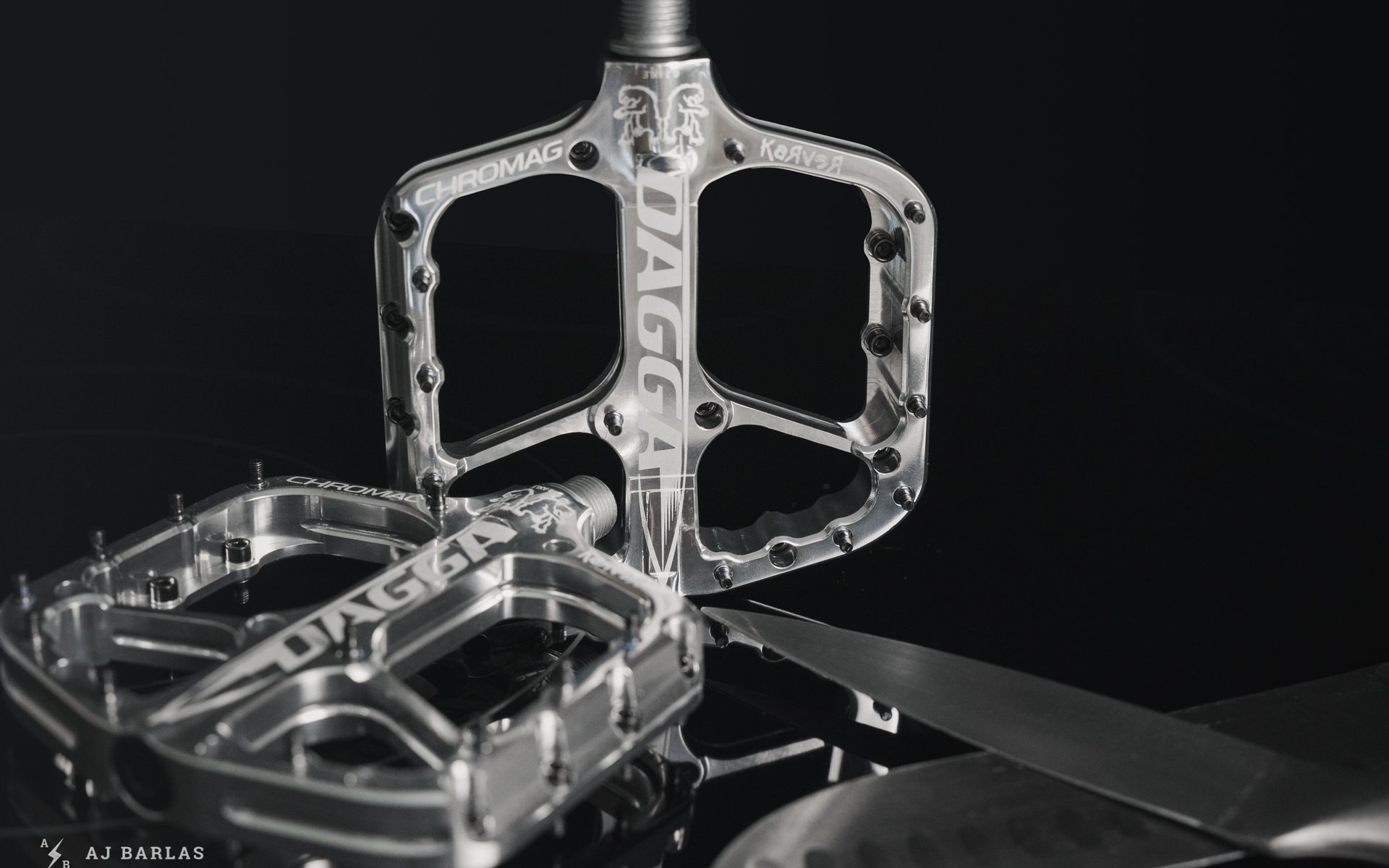
Kovarik's (Big) Flat Pedals For Medals?
Chromag Dagga Pedal Review
When Chromag launched the Dagga pedal late in 2019, there was heaps of interest in the aggressive pins and large platform. Less obvious was the attention to Q-factor that engineer, Ben Arnott and owner, Ian Ritz focused on. The Dagga pedal and its wider stance were initiated by Kovarik’s odd testing methods with his chosen pedals at the time. Slotting as many washers as possible between your crank arm and pedal body isn’t something many consider, or that anyone would openly recommend. Chris’s desire for a wider stance is what set the direction for the new pedal.
The second desire Kovarik had for the new pedal was the long, aggressive pins everyone has taken note of. They’re prominent, for sure, but simply moving to a longer pin isn’t always beneficial. Chromag and Kovarik discovered this during development when trying a longer version of the pins found in Chromag's Scarab and Contact pedals. That didn’t fly and left riders in the test group feeling elevated from their pedal, rather than glued down on it.
Eventually, Chromag engineer, Ben Arnott designed a custom pin to achieve their goals. As you can imagine, designing and developing a pin from scratch is no easy or cheap process.
Highlights
- 120 x 115mm platform
- Chromoly Axle
- Forged then machined 6061 alloy body
- 16mm thick at the outer edge
- Claimed 14.3mm at the centre (couldn’t get my callipers in there to confirm)
- Two outboard sealed bearings and one inboard DU bushing
- 12 pins/side. ~5.25mm tall stock with washers, ~6.76mm tall w/o washers (measured)
- M4 mount thread and smaller M3 thread for the pin–shoe stick
- Adjustable pin height with 1.51mm washers
- Weight: 244g/pedal (488g/set w/ full pins and pin washers)
- MSRP: 210 CAD / 180 USD
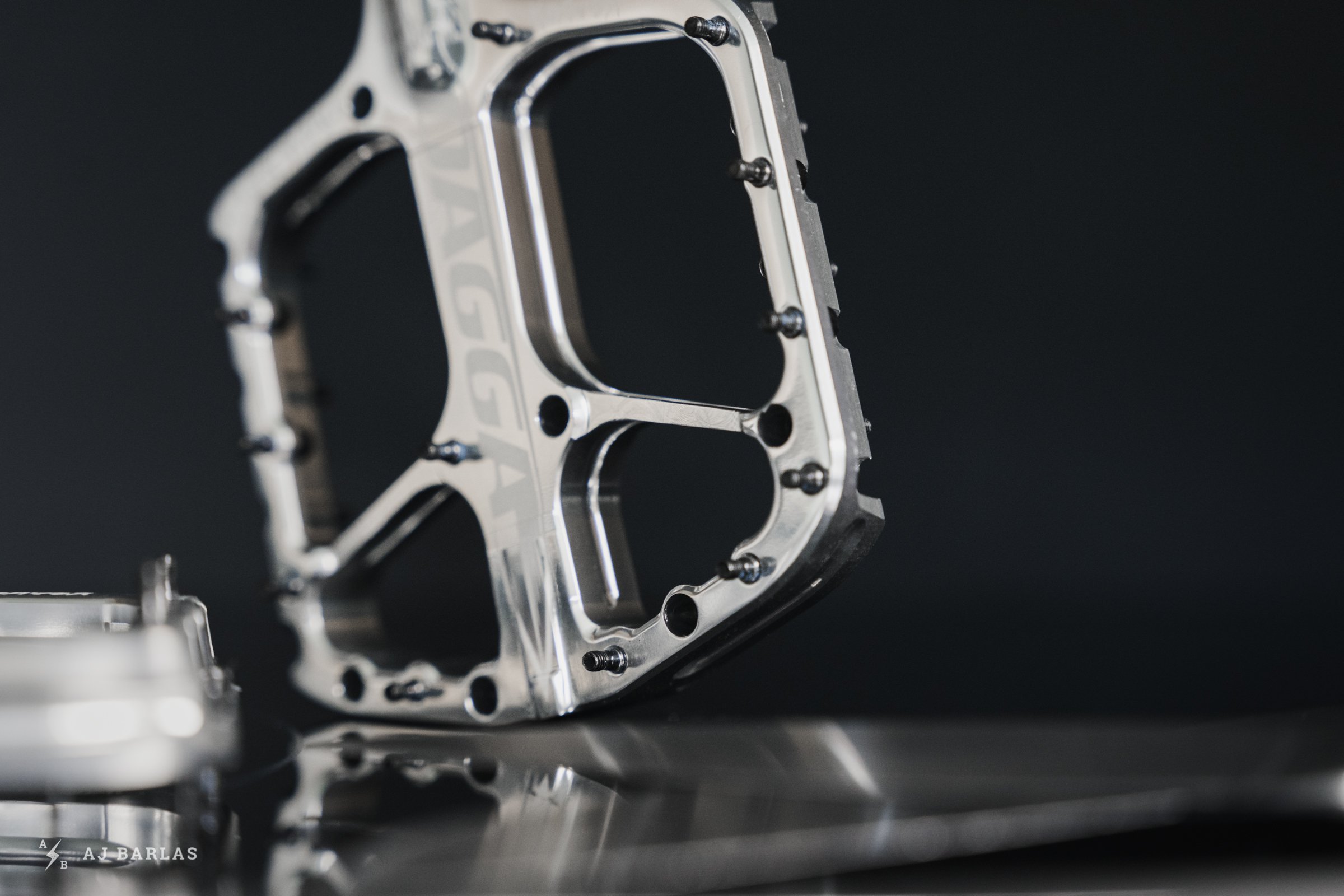
The Dagga pedal shares the curving, flowy lines of Chromag's other pedals, despite its bigger and more aggressive form.
The Details
Once you look beyond the protruding metal towers, the Dagga pedal shares Chromag's design language, which will be welcome for fans. While the platform is larger, the outline shares the smooth, rounded shape from the wide-point (at the axle) as the Scarab and Contact. The brace seen from the Scarab is also present, and the interface between the body, inner bushing and axle are also similar. These aren’t just aesthetic choices though. A rounded shape helps provide clearance from obstacles and the brace keeps the pedal strong, an important element of a pedal designed to smash shit. Aggressive flat pedal riders should be happy with the attention given to making the Dagga one tough mother.
The manufacturing process for the Dagga was selected with strength in mind. Rather than an extruded or fully CNC’ed platform, Chromag opted for a forged, then machine finished process. They claim that the forged process makes for the strongest block possible, and the machining is used to add the final details of the pedal. Pedals that are extruded or fully CNC’ed, like the DMR Vault or ANVL Tilt V3, are more prone to bending when handed a huge wallop—a problem I’ve had with the Vault.
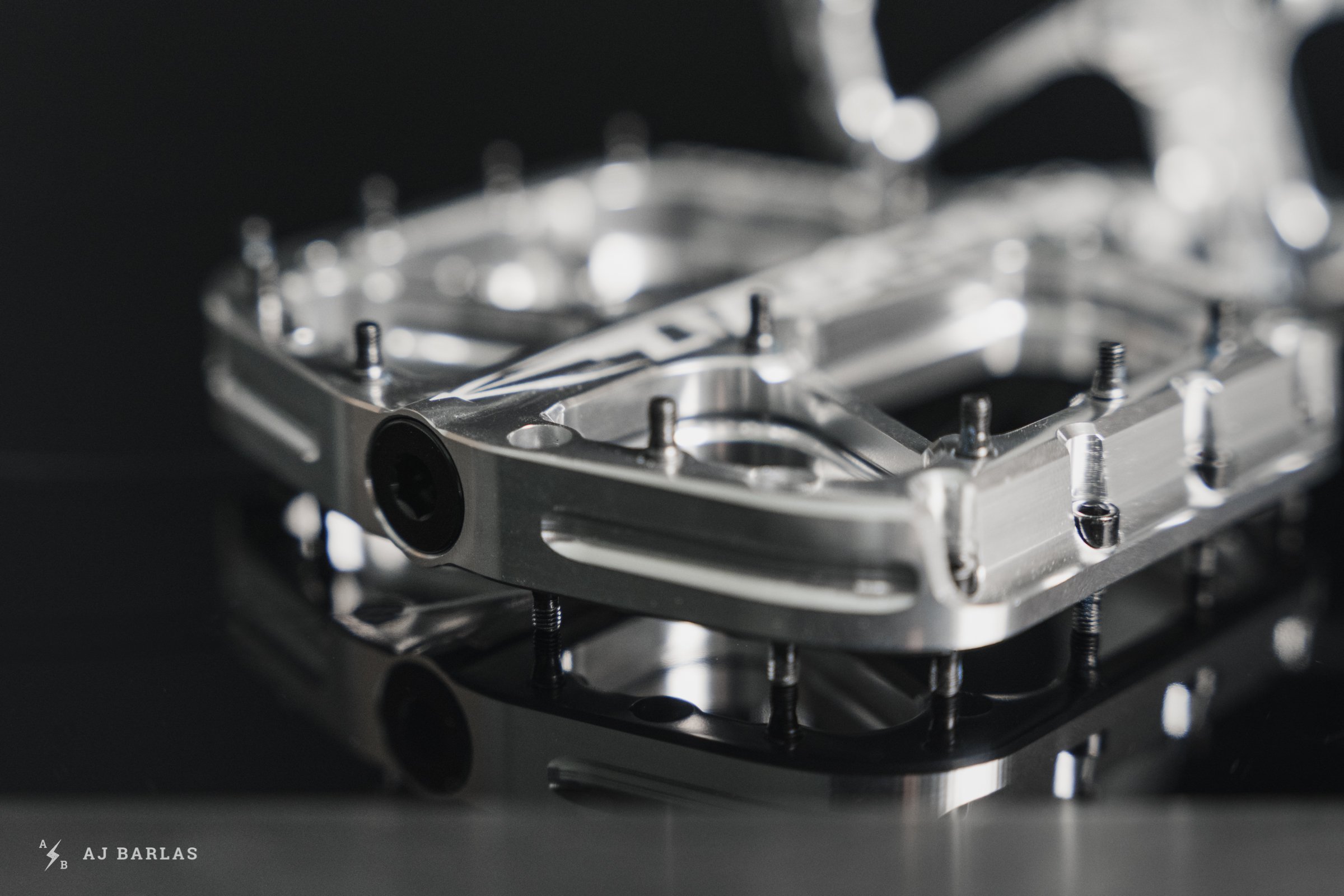
The rounded edges are solid thanks to the forged block of alloy in place of an extruded or full CNC'ed option. It feels strong and so far, after a number of solid smacks reveal no signs of weakness.
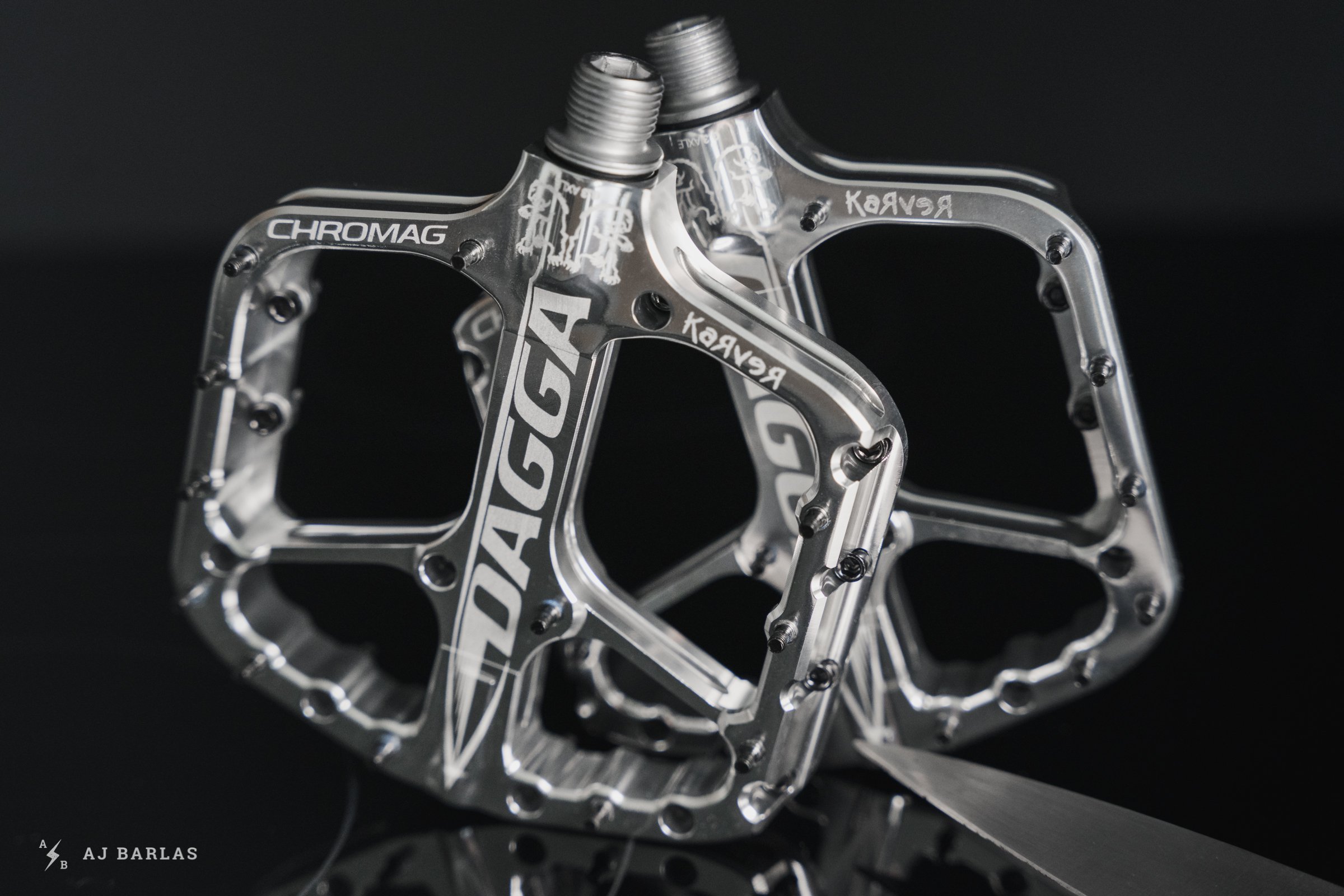
The brace from the axle to the outer edges stiffens the body but also hides a dagger image, a design aesthetic that Kovarik enjoys.
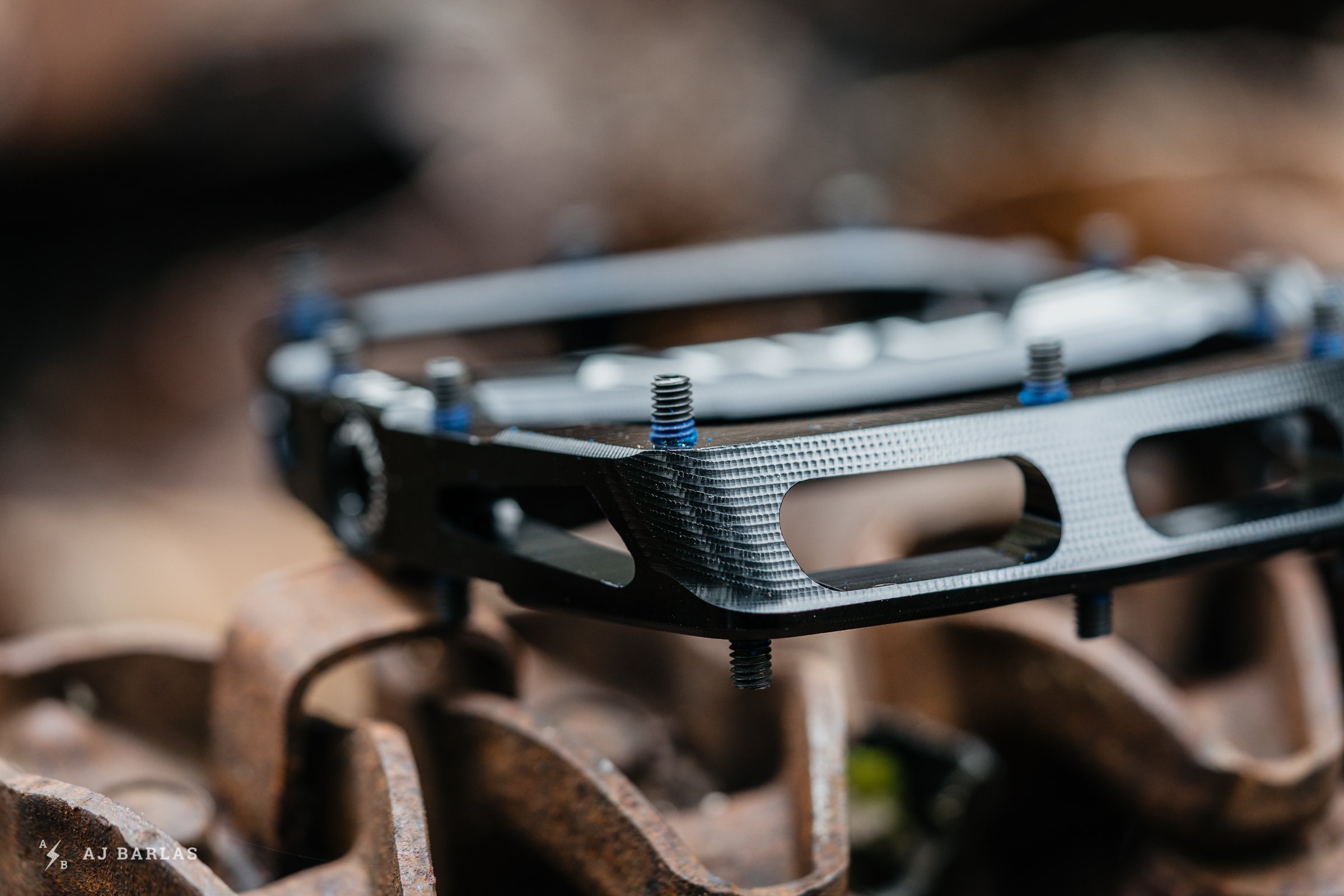
The ANVL Tilt V3 has hollowed out sections similar to the DMR Vault that I've bent in the past. I haven't bent the Tilt but I also haven't spent heaps of time on it since the review last year. Regardless, a solid piece of metal should withstand more impacts and is why Chromag chose the manufacturing processes they did.
Chromag's alloy pedals use a pin that mounts from underneath via an M4 thread interface. But for the Dagga, the pin was updated to increase traction. Chromag found that the older design from the Scarab and Contact didn’t provide the connection Kovarik was after. The new design uses the same M4 mounting interface but the tips have been updated to include a threaded, M3 head. The M3 threads help the pin stick into the rubber sole of the shoe while the narrower tip lets it bite in easier. This was especially important when moving to the longer pin option that Kovarik enjoys running on his downhill bike.
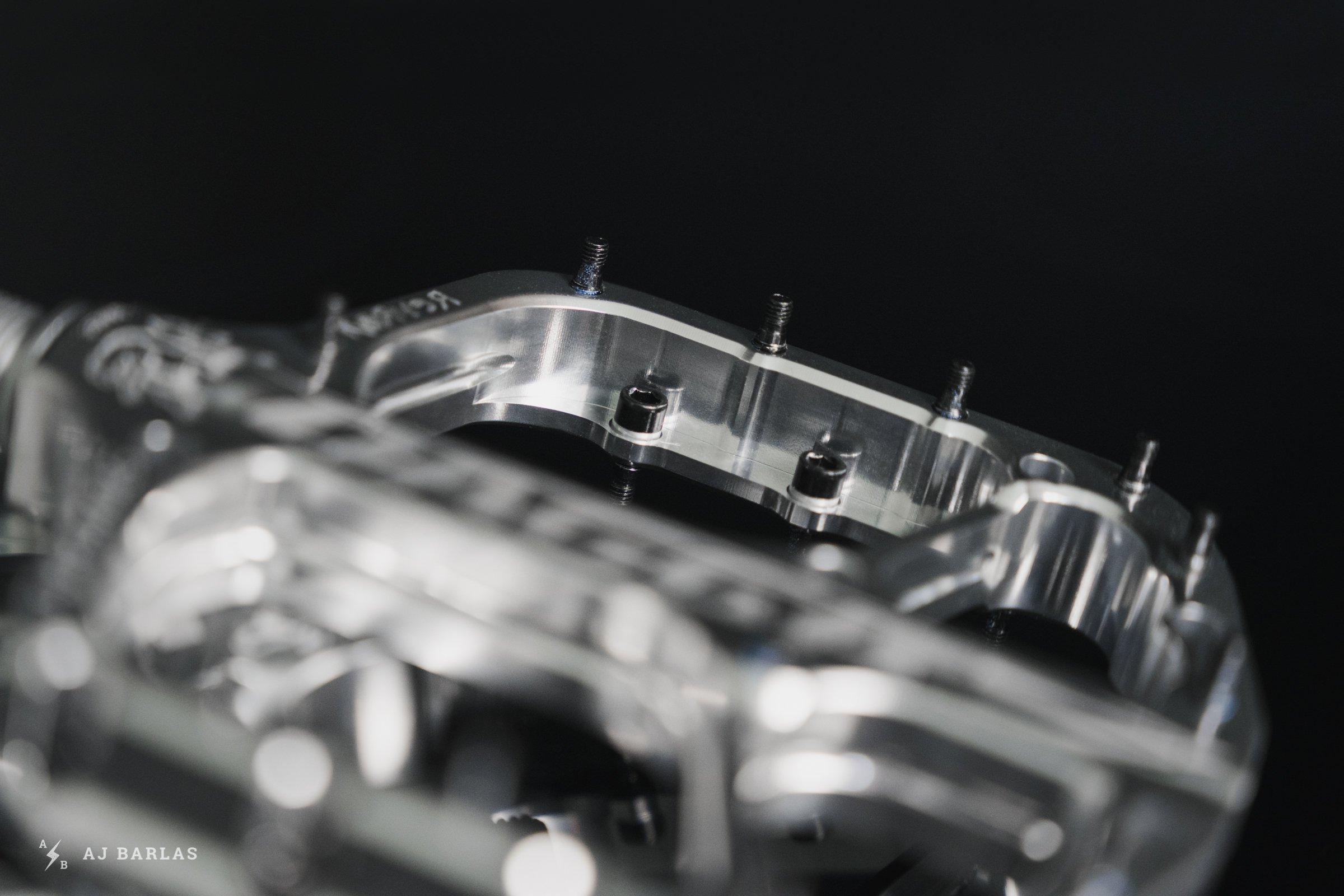
The long pins mount from beneath the pedal body. I've found myself bending the body of the pedal with a couple of others that mount like this but so far the solid body of the Dagga has resisted this urge.
Internally, the pedals spin on the same axle, using the same bearings and DU bushing setup as their other alloy pedals. While it sounds good having the same SKU and rebuild kits for their pedals, Chromag says it honestly came down to being the best option. A needle bearing option in place of the DU bushing was tested but found to be less durable while costing more—a less than ideal combination. Cartridge bearings in place of the DUs were also tested but Chromag found some riders preferred not to have the bulge this creates next to the crank arm. It also weighed more and increased costs.
Chromag Engineer, Ben Arnott also spent time researching and eventually testing alternate DU bushing options in the prototype pedals. After an exhaustive process with various DU bushing options, they found themselves back at square one, using the same bushing found in their previous pedals.
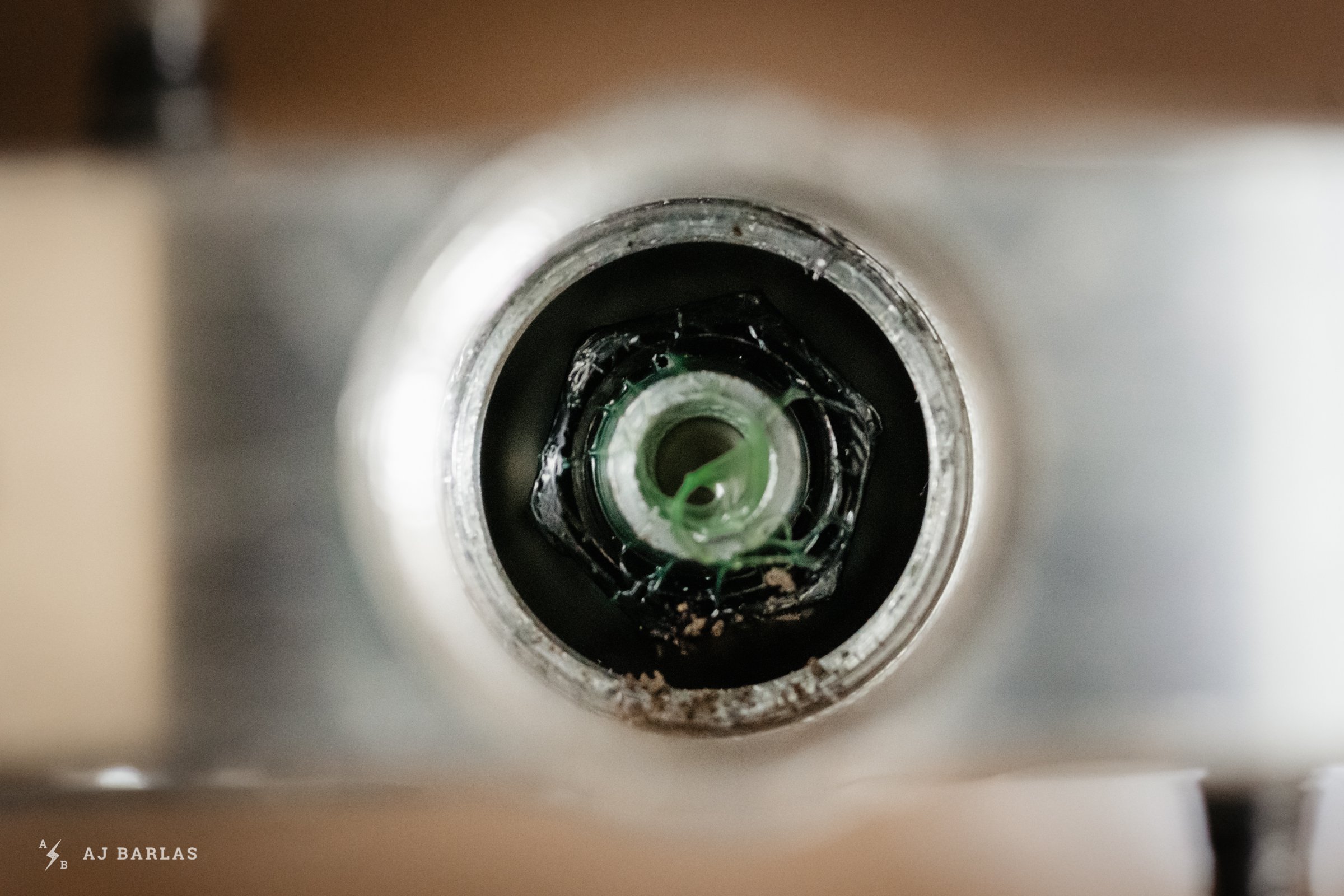
The washer around the mounting nut is less obvious with the raw alloy Daggas but it's the lip visible by the nut. It won't be in future pedals but a thinner 8mm socket is available for first production pedal owners who want to service their pedals.
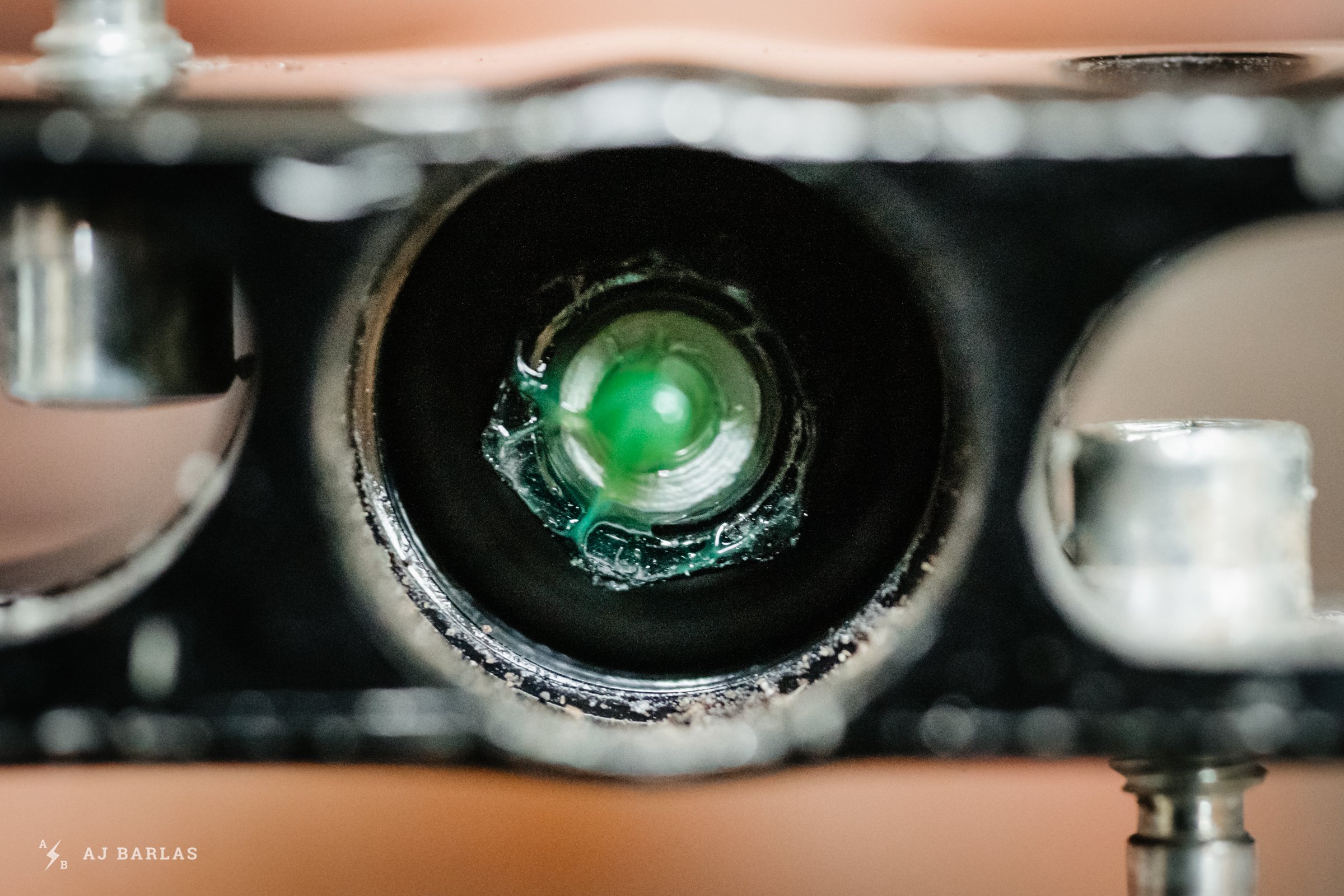
And the black Scarab pedals I have makes it difficult to see in around the nut at all. If looking closely, the extra room around the nut can be seen and with my usual 8mm socket I can easily remove the nut to take the axle assembly apart.
Taking the pedals apart to service and nose around proved more difficult than previous pedals I’ve used, including the Scarab. The pedal still uses an 8mm nut beneath the end cap, accessible with a small socket. But the socket I’ve used for years on countless pedals, including the Scarab, was too thick to fit. Ben informed me that the wider platform of the Dagga pedal needed a different approach to secure the end cap. Early production pedals, like the ones tested here, have a spacer between the body and end cap that allow everything to snug together. Chromag's final prototypes had this washer and it was easily removed but unfortunately, the washers are tightly held in place in the first production pedals. Arnott has since redesigned the end cap for the Dagga, making it longer and negating the need for the washer. Chromag has sourced a steel socket to fit the 8mm nut in the early production pedals, for those who need it.
Because the Dagga sits further out on the axle, this meant there was some space between the bearing and where the cap would end up when it was flush with the outside of the pedal. So, I designed a simple spacer to take up this gap. – Ben Arnott, Chromag Engineer
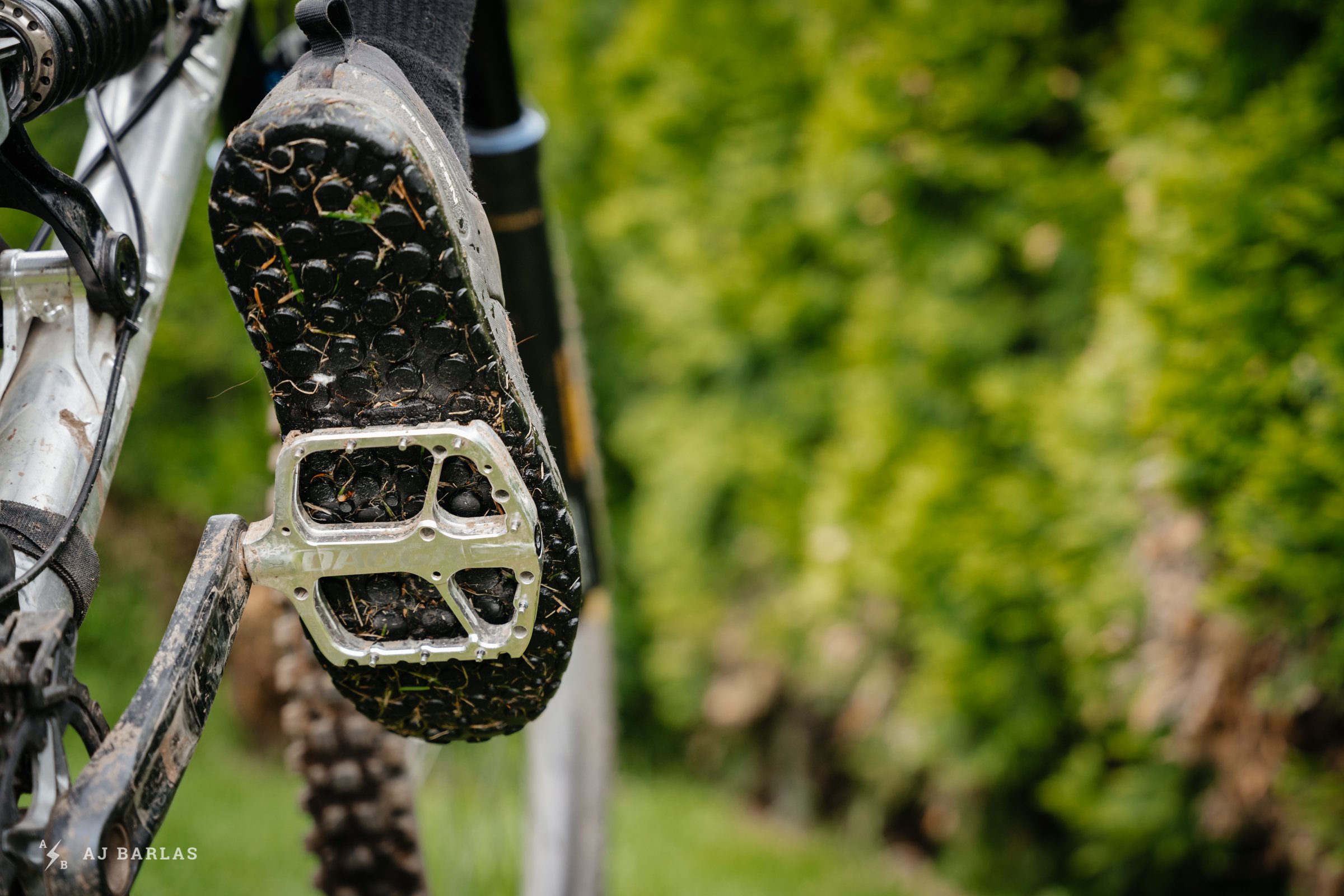
They sound big on paper at 120mm wide but a pair of size 10.5 US FiveTen Impact Pros still hang over the outer edge, with the foot reasonably tight next to the crank.
Karving
Stomping down on the Dagga pedal, it didn’t feel as large as the numbers suggest. Considering the dimensions put this at the upper end of the largest flat pedals available, some riders may be concerned that these will be too big. I never found that to be the case and the shape of the platform makes them feel smaller underfoot than something like the Deity TMac. Their size feels more like the smaller on paper ANVL Tilt V3 or Nukeproof Horizon.
Chromag has made a big grippy pedal, that increases the Q-factor without creating a metal e-brake under your foot. I haven’t experienced an increase in pedal strikes and they’ve spent heaps of time on a test bike in addition to my own, both on local and distant unknown trails. While the Q-factor is certainly wider than the Scarab, I found it similar, if not identical to the TMac pedal, and comparable to the slightly smaller-platformed Nukeproof Horizon. For the last four years, when not testing pedals I've found myself spending most of my time riding the Horizon and TMac with most aboard the latter. Switching to the Dagga pedals didn’t present any problems or benefits in terms of Q-factor based on this experience.
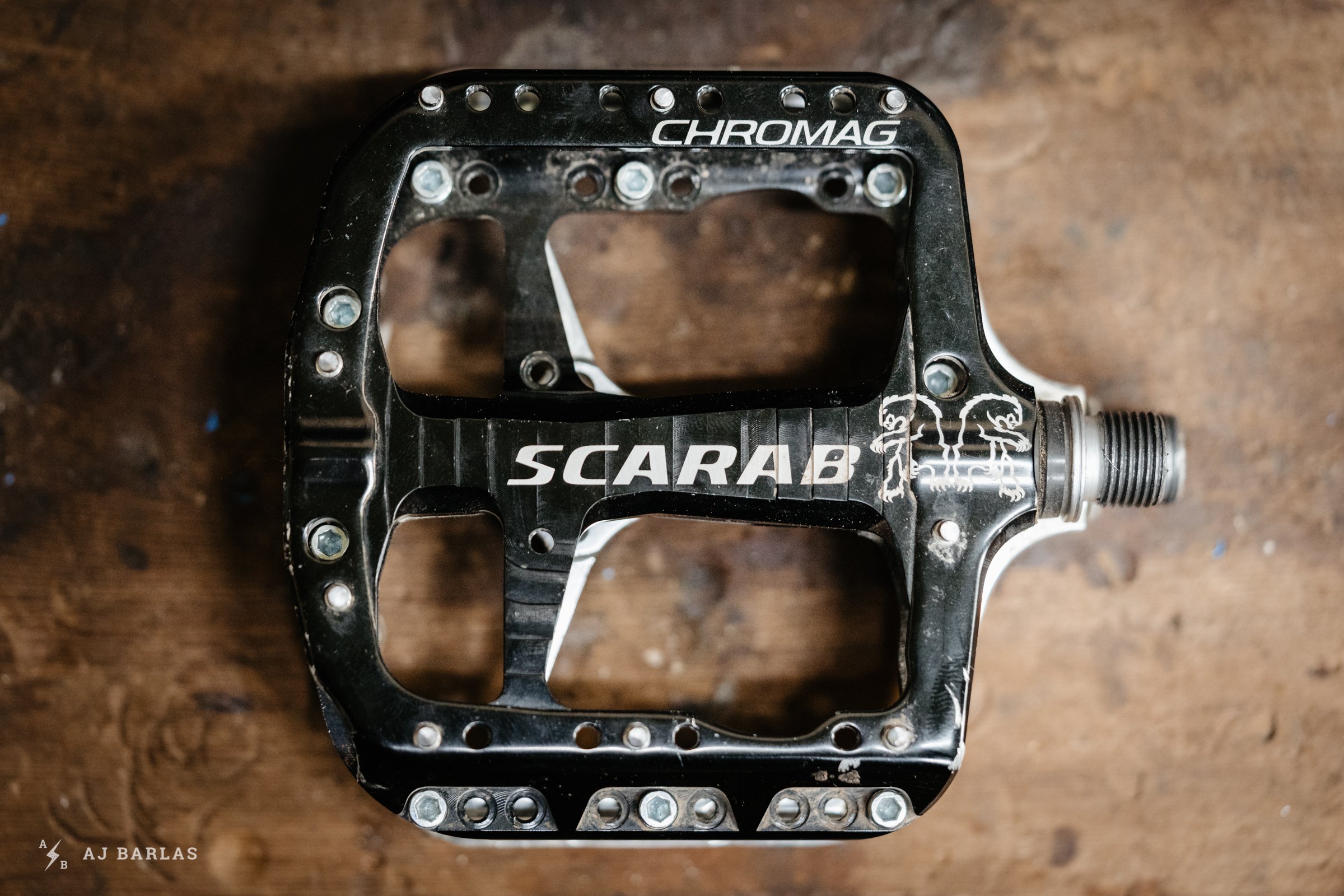
Compared next to the Scarab, the body size doesn't differ much…
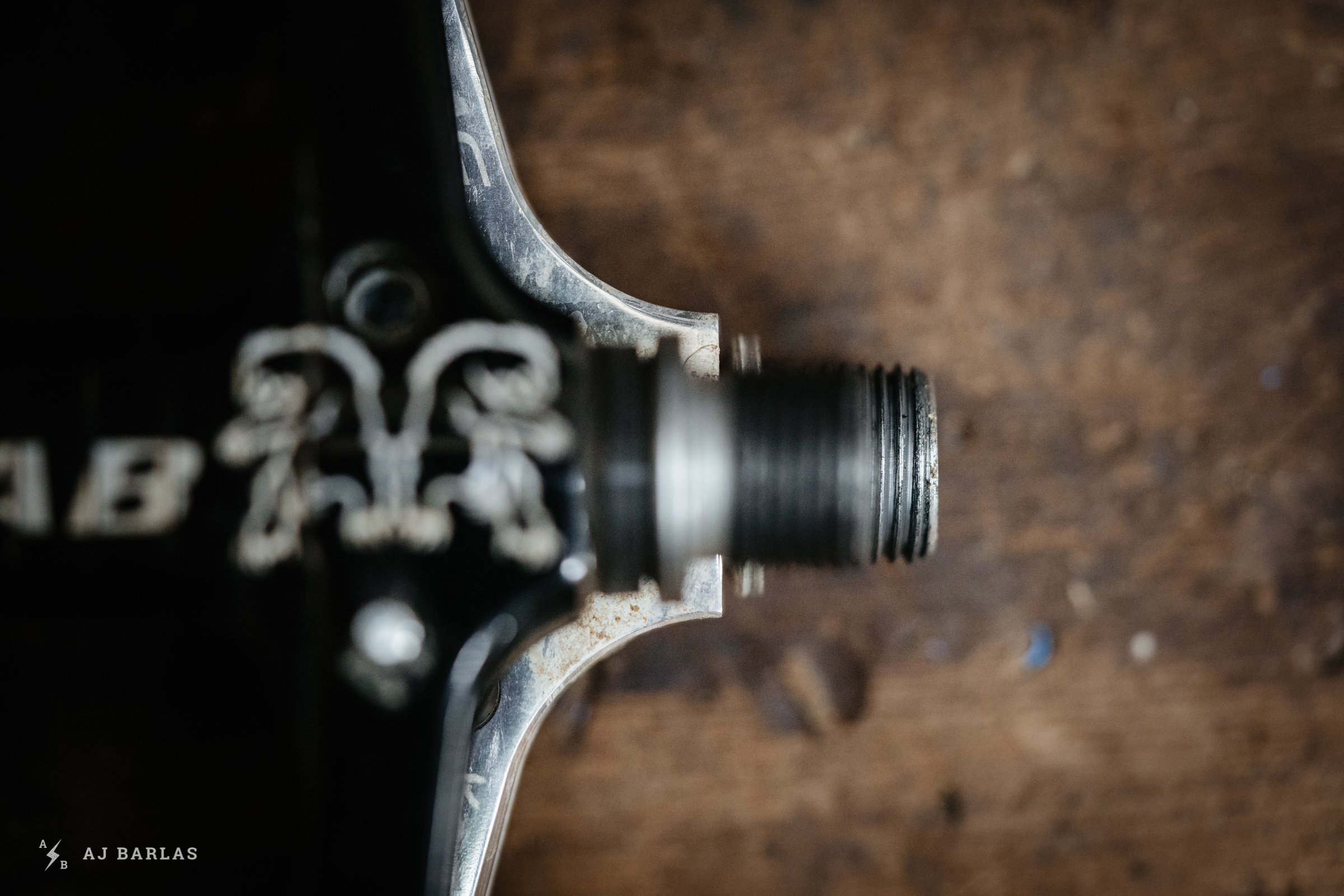
But the width of the platform starts further out from the crank. This is where the q-factor, or widening the stance of the rider, comes into play.
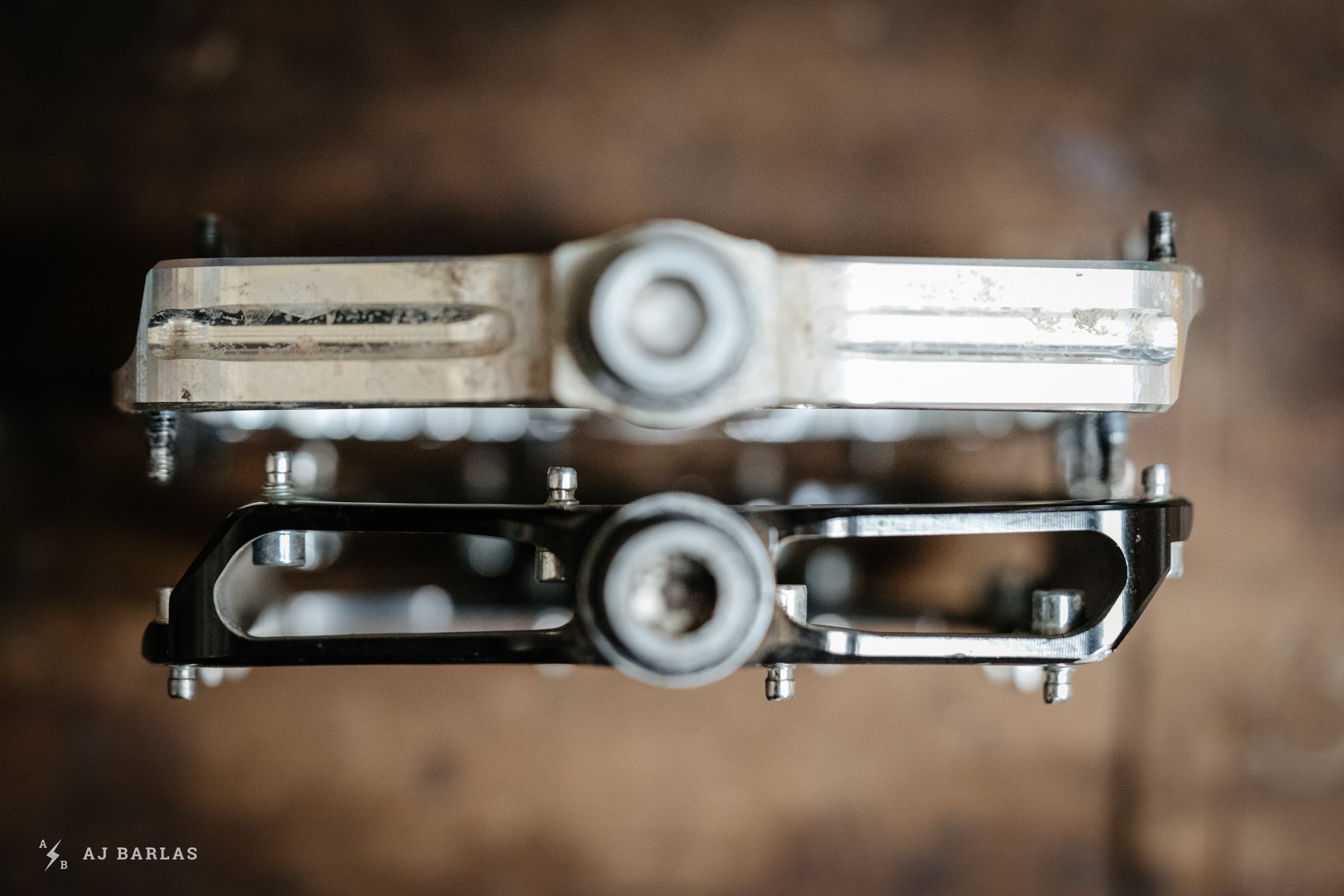
Length, on the other hand, has increased considerably compared to the Scarab. The bevel leading edge is steeper on the Dagga, keeping the offset and foot more centred over the axle.
The wider stance offered by these pedals feels good on the trail, providing a stable ride without being so wide strikes become an issue. Chromag has done a great job to squeeze out as much surface area possible without massively increasing the overall outline of the pedal. This became more apparent when comparing the Dagga to the Scarab, which shows next to no difference in width at the contact points – where I feel more emphasis should be put rather than the static outline measurements. I find the Scarab and Dagga differ most in length and that transfers to more support underfoot. A longer pedal helps prevent foot issues like cramps, provides more efficient power output, and increases grip and stability.
Shoes are an important piece of the flat pedal puzzle and when considering a larger pedal, also consider preferred footwear. I’m riding in a pair of US10.5 FiveTen Impact Pros, which Kovarik also spends heaps of time in, and have found that the wider Q-factor, bigger platform pedals like the Dagga or T-Mac work well. With shoes that feature a smaller footprint, I've found there to be a loss in feel and some pins go unused in some situations. Shoes that I’ve found this to be the case include the older Giro Chamber, 2019 Shimano GR9 and FiveTen Freerider Pro shoes. Their slimmer width can land them in no-mans land, leaving valuable portions of the platform and pins untouched
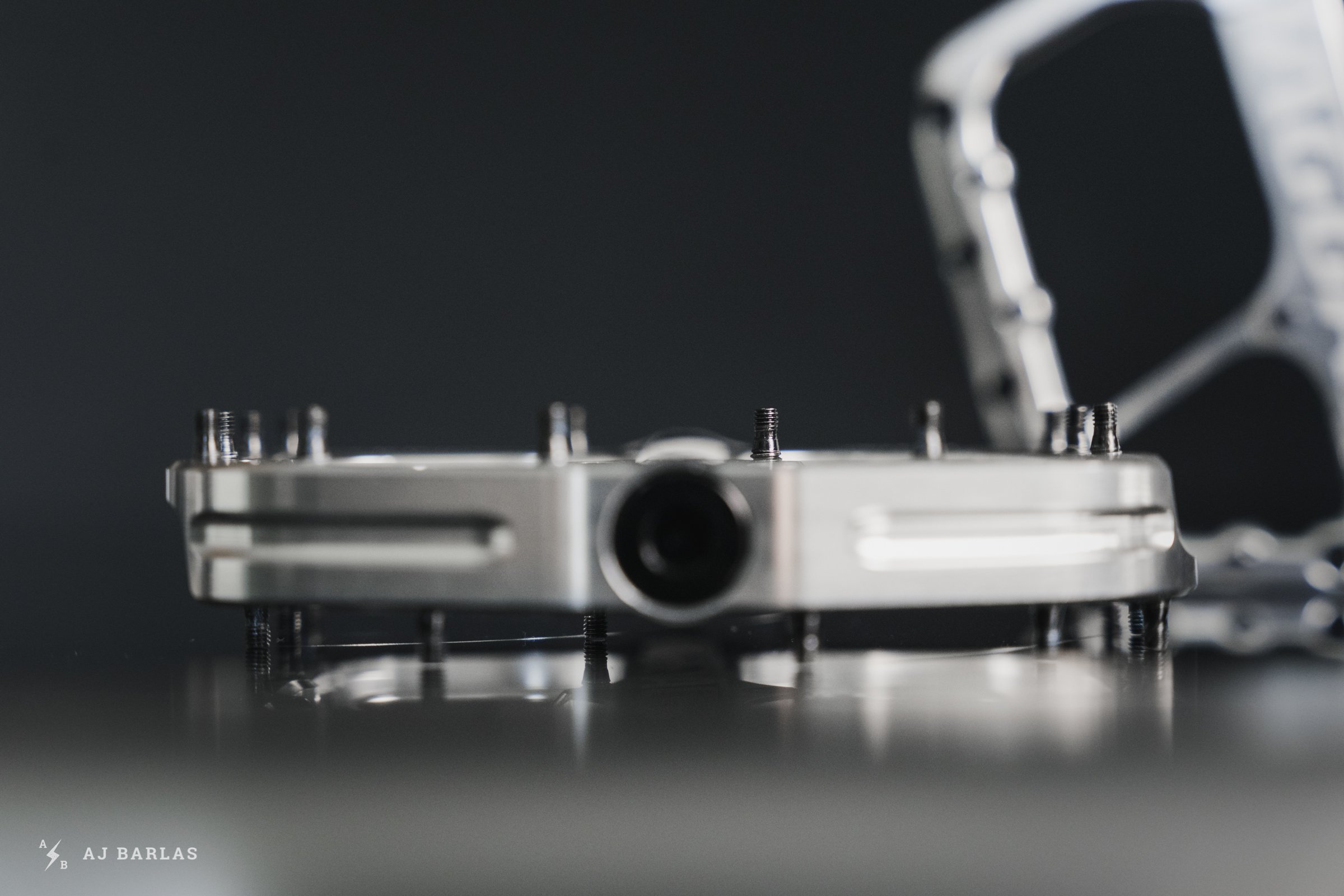
Those glorious pins. Don't be scared. You'd have to worry if they weren't so good at holding your foot in place.
Stomping on Metal Towers
It’s difficult to hide the pins on the Dagga. Their stock height stands them roughly three-quarters of a millimetre taller than the pins on the Scarab pedal and similar when compared to the Deity TMac. The only pedals I have that come close are the ANVL Tilt V3, but they’re still a bit shorter despite the longer than stock pins. Despite the length, the pins in the Dagga don’t push the shoe off the surface of the pedal body. The choice to move to a smaller diameter pin head was a great one, and these dig into the sole of the shoe feverishly. Even at their extended length, the pins go largely unnoticed, allowing the shoe to position comfortably on the pedal body. There is a change in feel when extending or shortening them, but it’s minimal and not something I found problematic. For reference, I find the pins on the DMR Vault too large in diameter, elevating the foot from the pedal more than I’d prefer.
Out of the box, the Daggas come with 12 pins per side. After threading them into my cranks and having a bounce on them, I removed one. I’ve never liked a pedal with a pin in the middle of the foot. Despite the thin profile, the central pins still left me feeling like I had a rock in my shoe. After some time riding on the pedals, I also removed the pin by the axle, something I regularly do with pedals that allow it. A pin in this location is common with today’s pedals, as it helps counter the bulge of the axle from interfering with traction. Once removed on the Daggas, grip remained great.
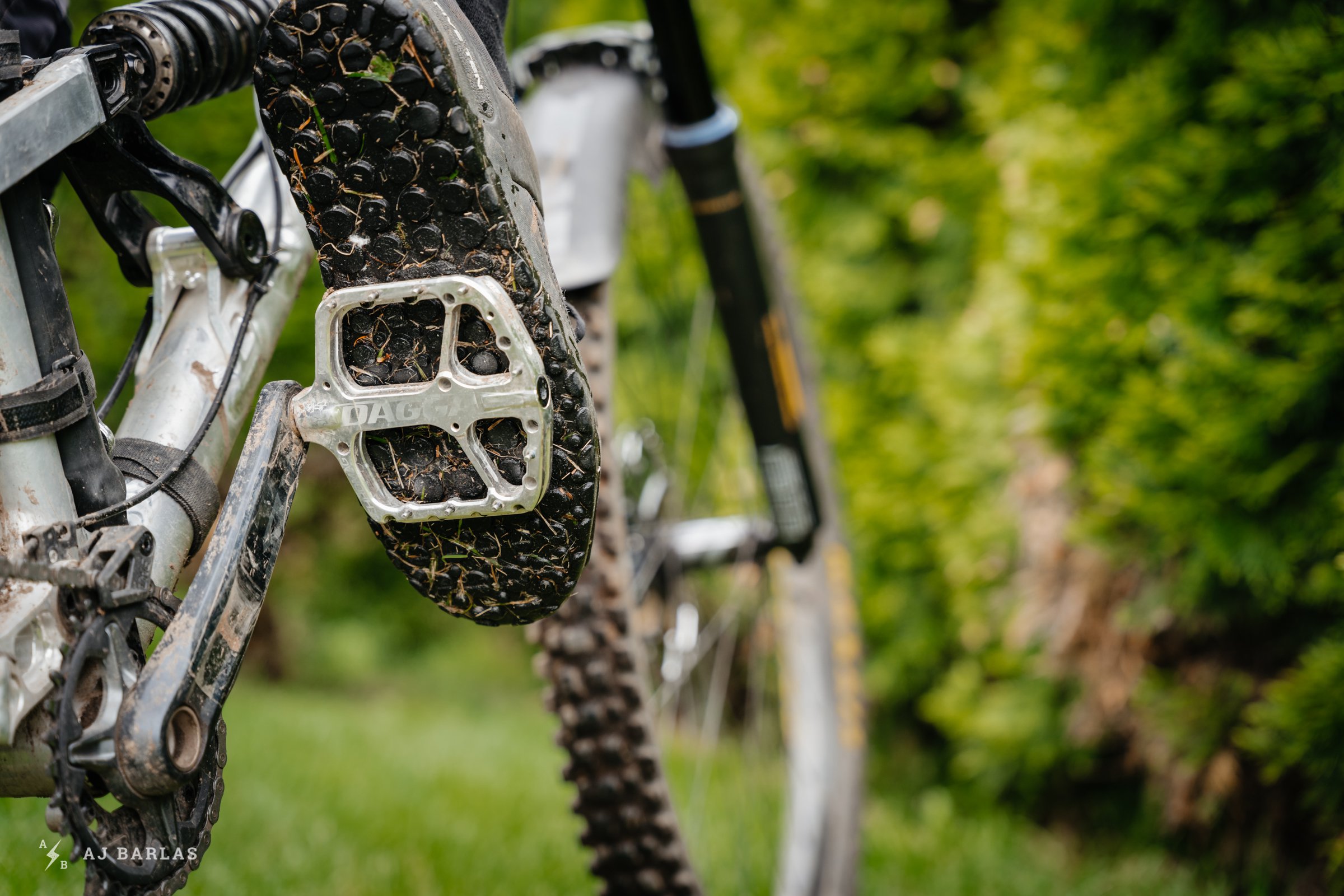
A close look and you can see the final pin placement I settled on. With such great grip on offer, the Dagga can easily have pins removed and still hold a shoe firmly in place. For me, the grip improved after strategically removing some.
It only took a few rides to feel completely at home on the Dagga pedals. Shortly after those first rides, I decided to start toying with the pins again. With 24 super grippy pins in each pedal (down to 20 for me) it’s fun to customize the setup. I started from the outer edge where there are three pins, removing the one immediately back from the row of four pins on the leading edge. This was done in hopes that I could increase the cup into the body of the pedal. I enjoy a concave platform but the ~1mm concave of the Dagga body left me seeking more. That move worked but the best result was using this configuration in the tall setting; four leading-edge pins, two outer edge and three trailing edge. The stock shorter pin setting was placed on the outer edge, creating a nice concavity, cupping my feet into the bike.
The difference in traction with this configuration and the pins On the leading and trailing edges set at their tallest height was unreal. I found that the foot could unweight from the pedal but still be held relatively still, keeping it in place for longer on rougher sections of trail. During testing, repeatedly switching from the standard to long pin height provided a subtle but clear change. There’s plenty of traction with the standard configuration but for the most grip possible – more than many will need, myself included if I’m being honest – then the long pin setup is the way forward. Pedal feel remains more-or-less the same but the pins dive deeper into the shoe sole.
Those 3mm pin heads work a treat but there is one downside. Even at stock height, the pins eat away at the sole of the shoe more than others. After nearly 2,000km on my FiveTen Impacts (more on that soon), mostly with the Deity TMac and Nukeproof Horizon, the soles have faired really well. Normally after a season, the sole of my FiveTen shoes is toast but these have proven to be really durable, more-so than my earlier Impact Mids and much more than my early Freerider Pros. Since testing the Chromag Daggas, those narrow, tall pins have chewed away at the sole, shortening the shoe's lifespan. Like most things, there are trade-offs and the grip provided by the Dagga pins will cost you in worn out shoes.
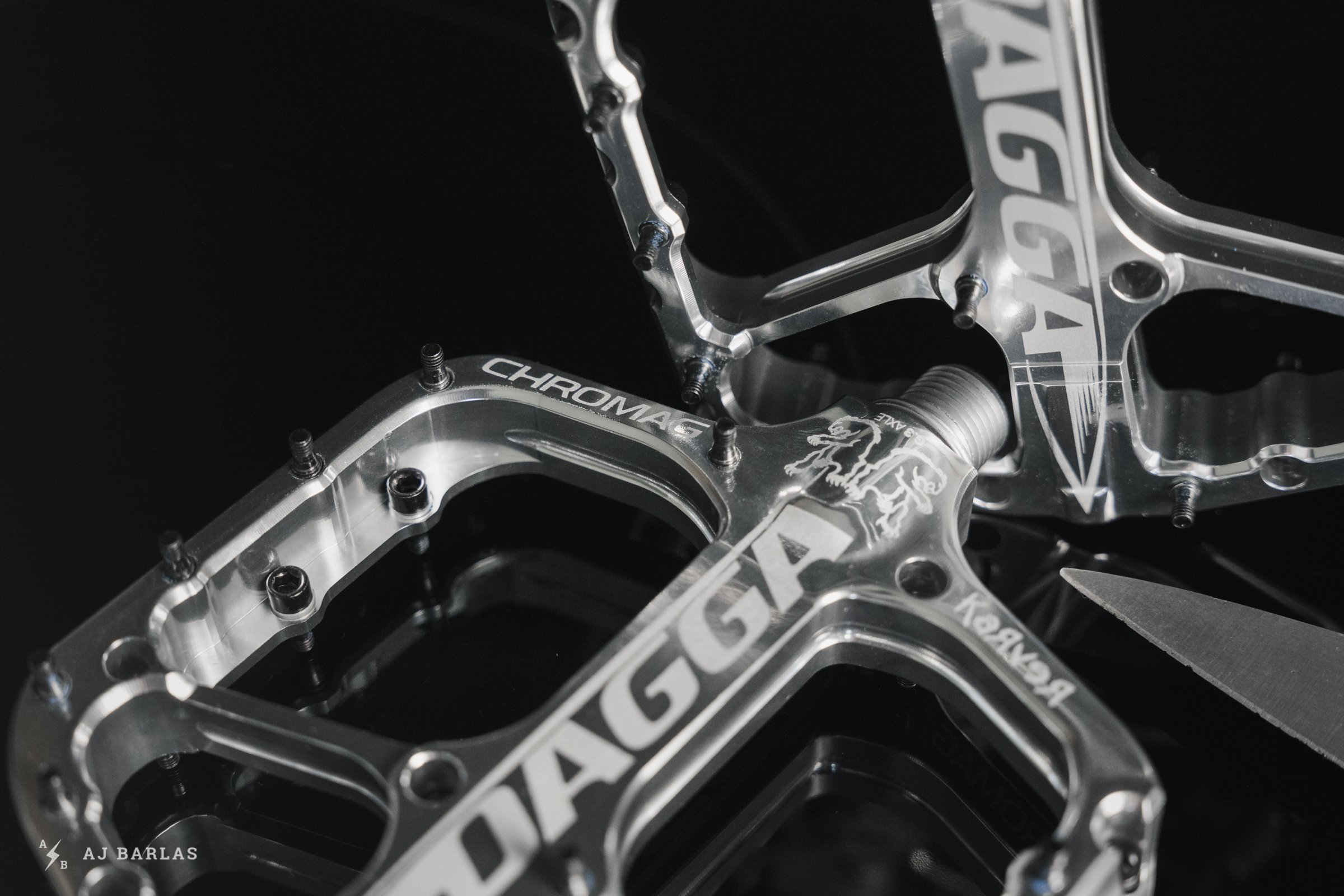
They're big but stack up similar to some other large platform available.
A Note on Sizing
After first realizing the Daggas size didn’t look as big when across from a set of Tmac pedals I decided to dive a little deeper. This isn’t to say these pedals are good or bad, but it is interesting to measure them up against others. Not pictured are the DMR Vault and new e*thirteen pedals, which aren’t far off in size either, despite on paper being considerably smaller. Over the years I’ve learnt that the static sizing for flat pedals often doesn’t transfer when it comes to how they feel. With curved shapes and bevels here and there, two pedals of the same size can feel quite different underfoot. The rounded outer edge on the Dagga removes quite a bit of material compared to others. Consider the shape of the pedal when looking at their size. The Dagga isn’t an especially large feeling pedal thanks to the rounded shape.
Below are some comparisons to other pedals I've gotten along with well and still have in my possession. Each pedal was also measured to provide further insights. The measurements can be found in the final slide for each. Why do this? Because while pedal manufacturers continue to provide measurements based across the widest and longest points of the body, the diagonal and width of the front/rear edges are also important to give an idea of feel. It's through these measurements that the size of the Dagga not being a problem on the trail becomes more apparent. This is getting bloody nerdy for a set of flat pedals but I was interested in the actual measurements when they appeared so similar in size in my hand and thought it may be helpful for some.
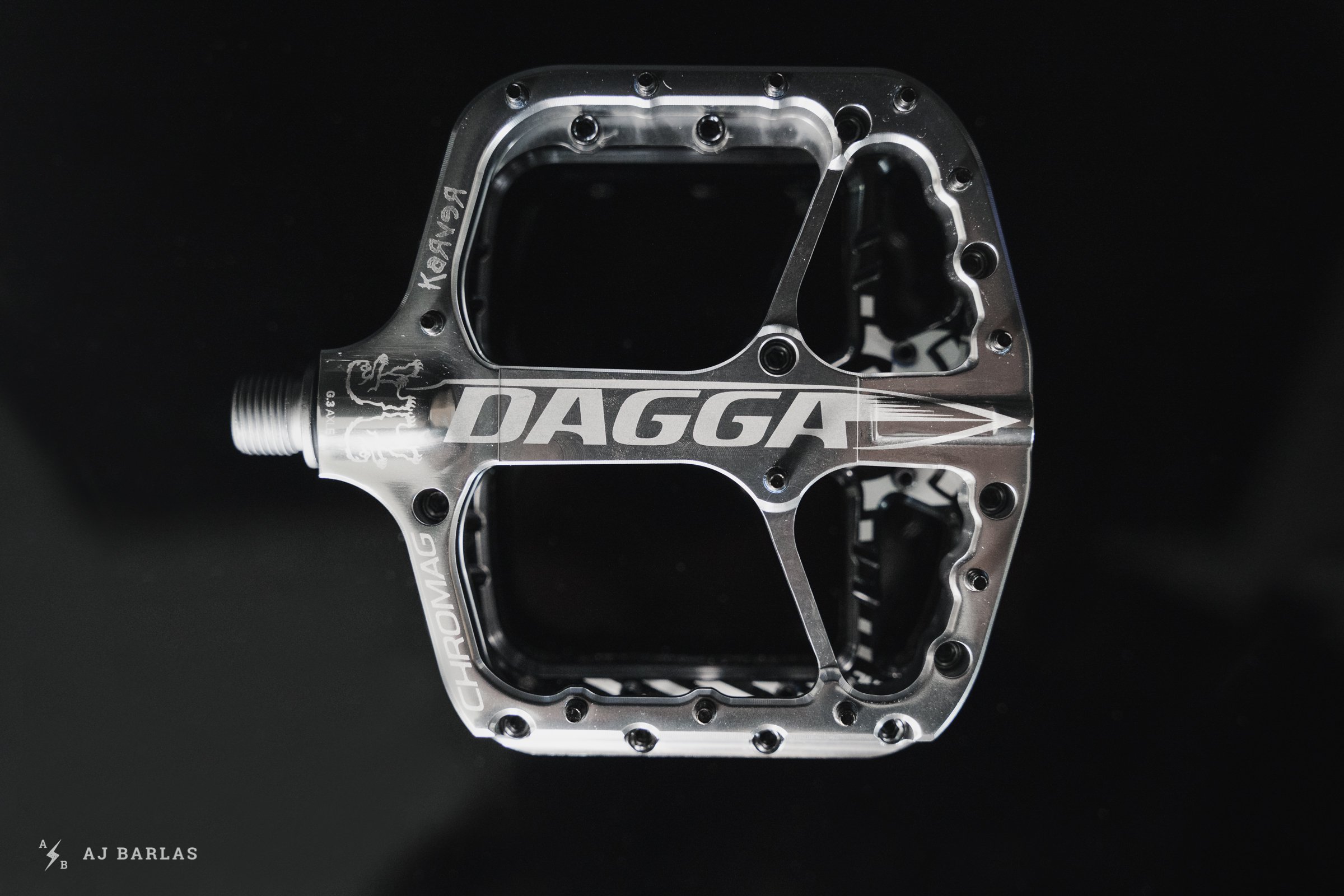
The Dagga on top of the Deity TMac. These two are almost identical in size. The rounder edges, creating a shorter width at the front and rear of the pedal make the Dagga feel smaller on the trail. Scroll through for side-by-sides and more angles…
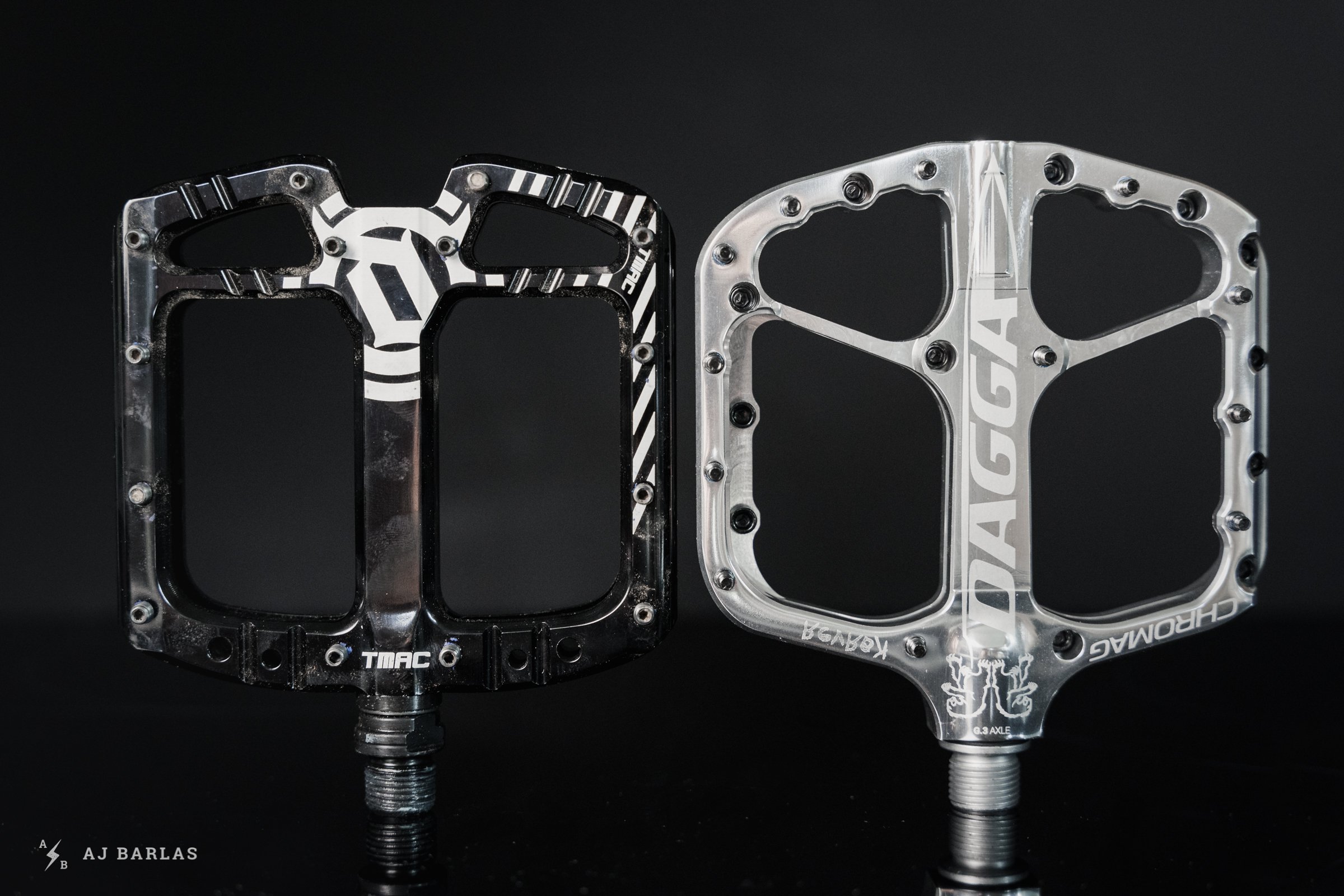
Net to each other the squarer outline of the TMac becomes clear. The q-factor of them both appear to be the same
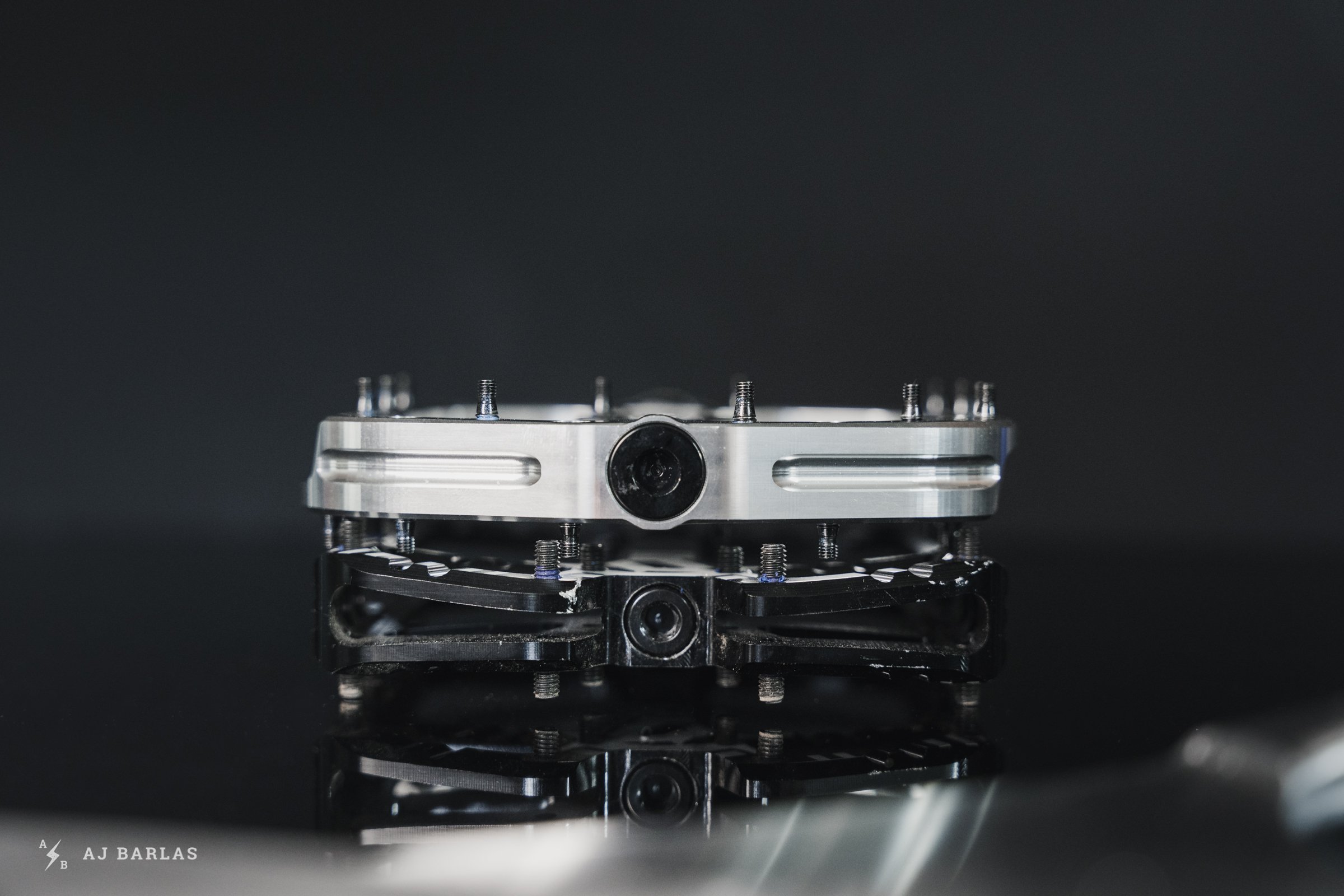
Lengthways the pedals are within a millimetre of each other. The large concave of the TMac is also obvious here.
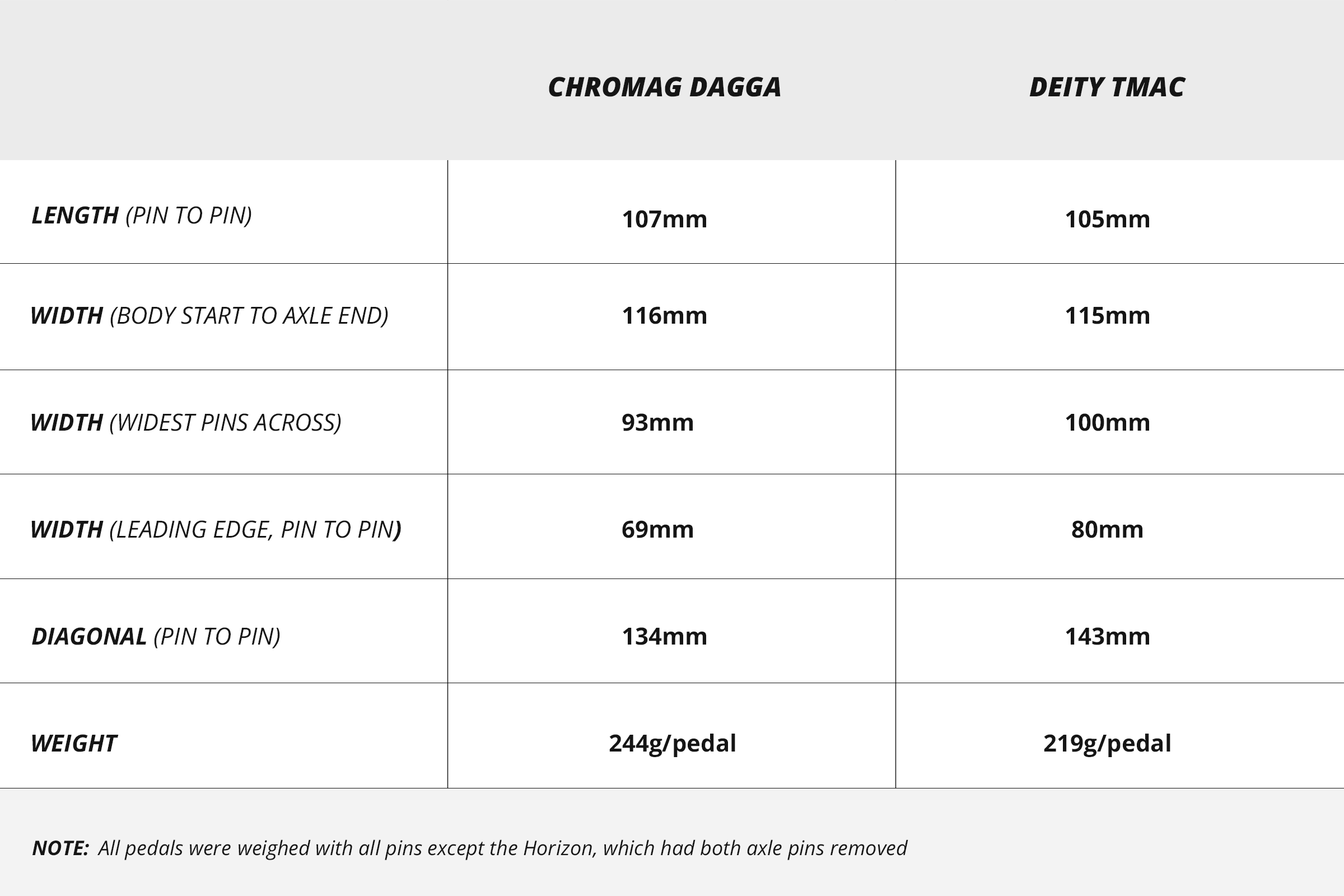
How the Chromag Dagga measures next to the Deity TMac.
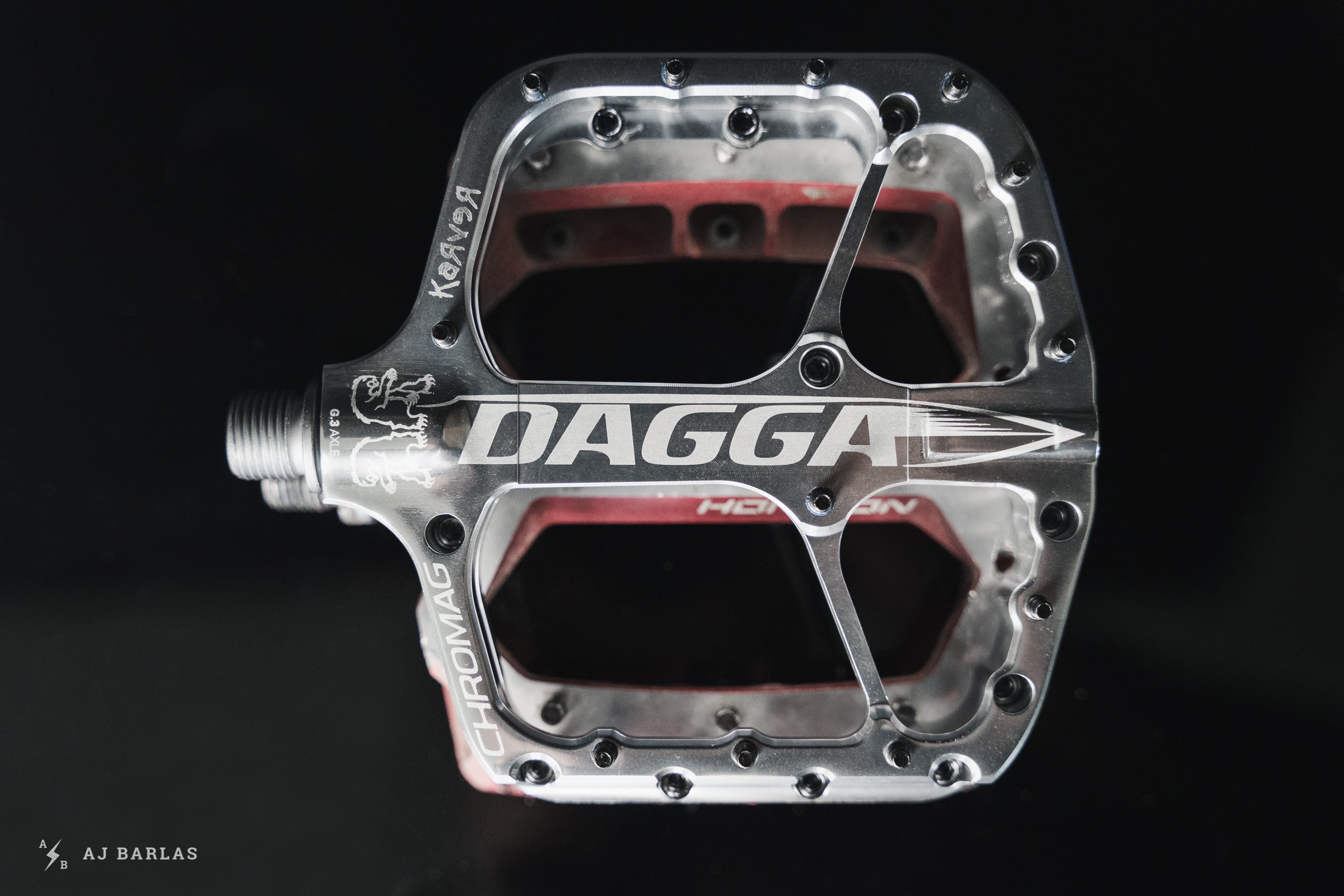
The Dagga on top of the Nukeproof Horizon. These two also share some similar measurements. The original Horizon (not to be mistaken with the latest version) features squarer edges and outline.
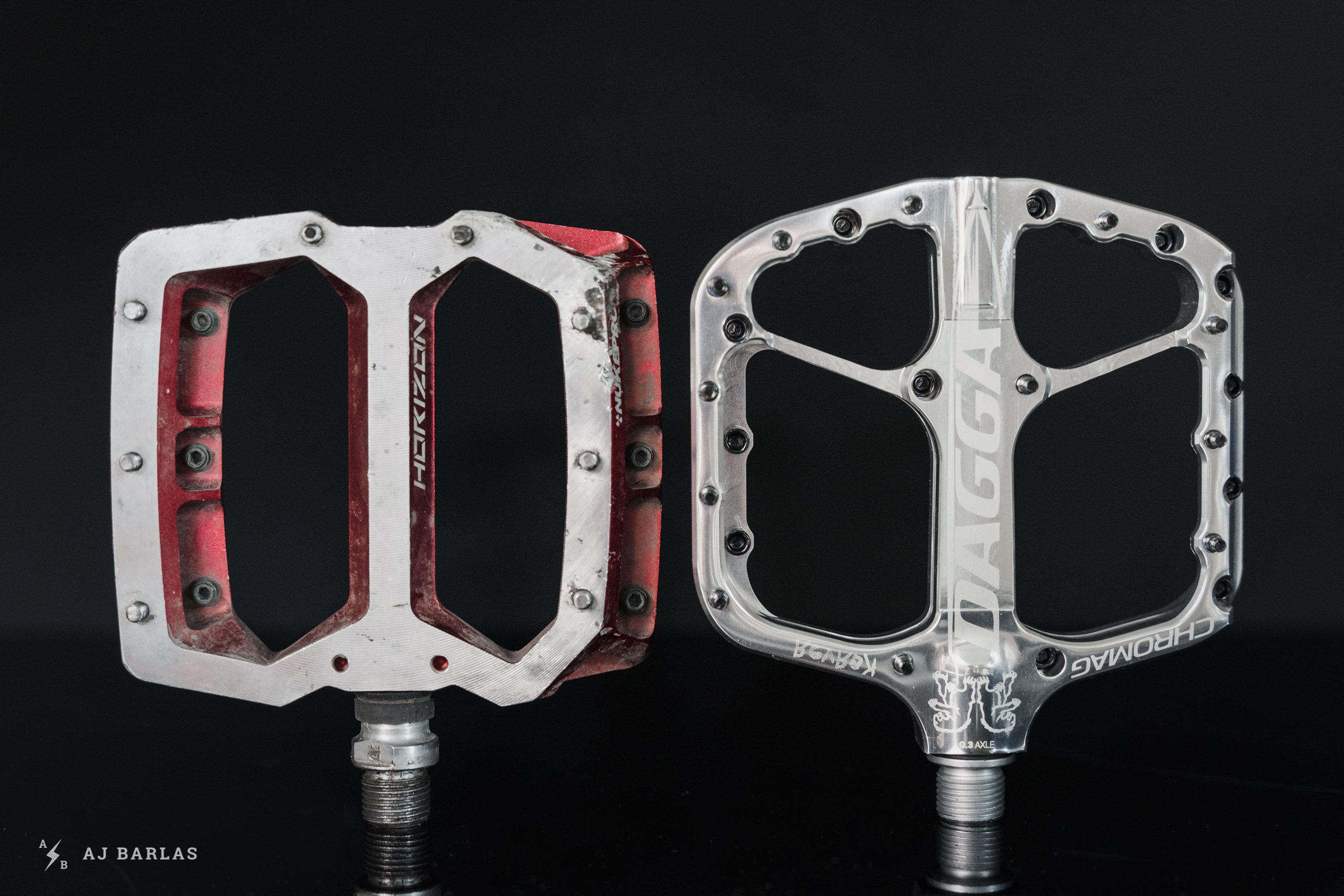
Side-by-side it's clear that the length of the Horizon is shorter but the wide lead and trail edge make for a larger surface to stomp on when everything is added up. I find the q-factor of these to be similar.
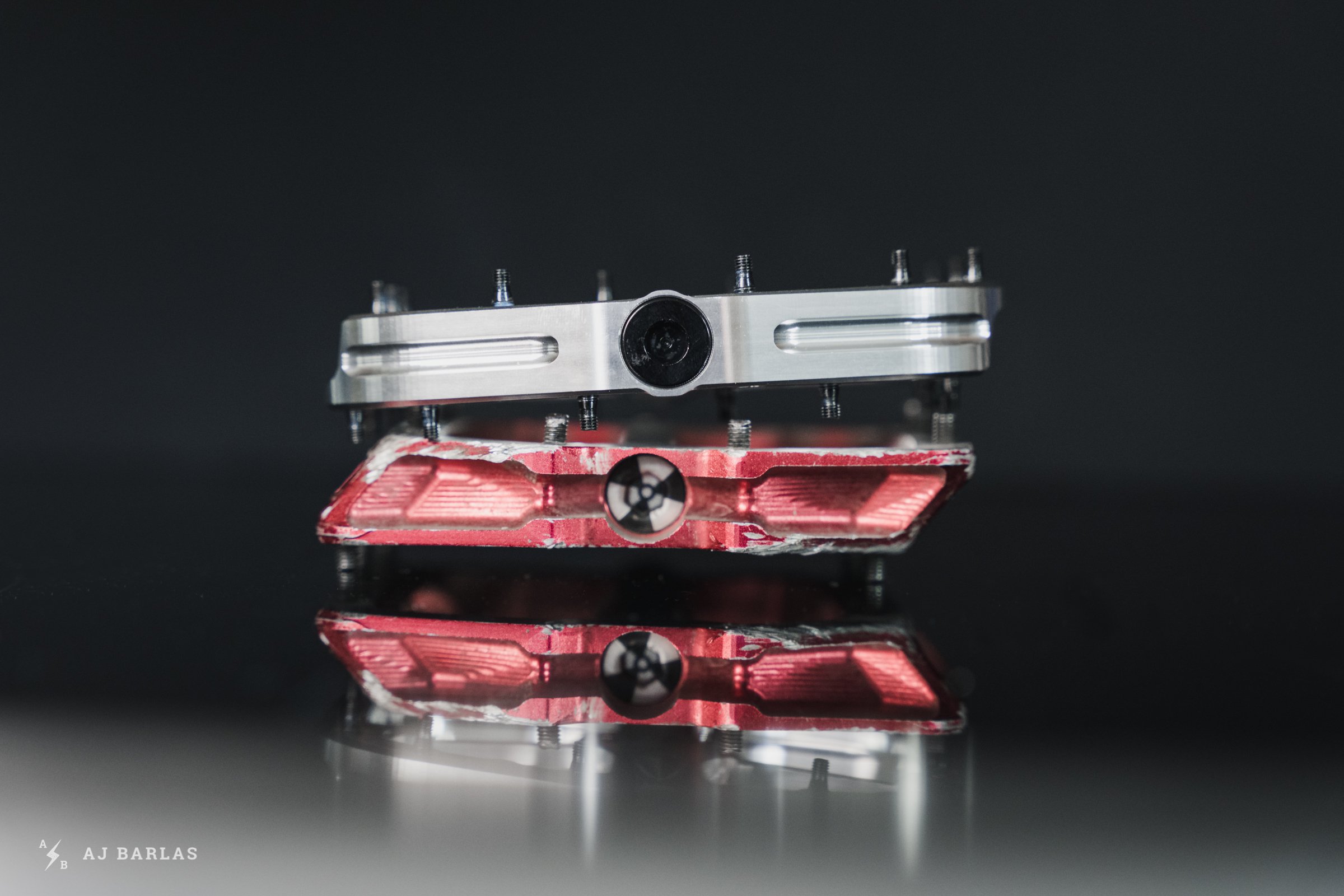
These two didn't play nice when stacked on top of each other but the extra length of the Dagga is visible.
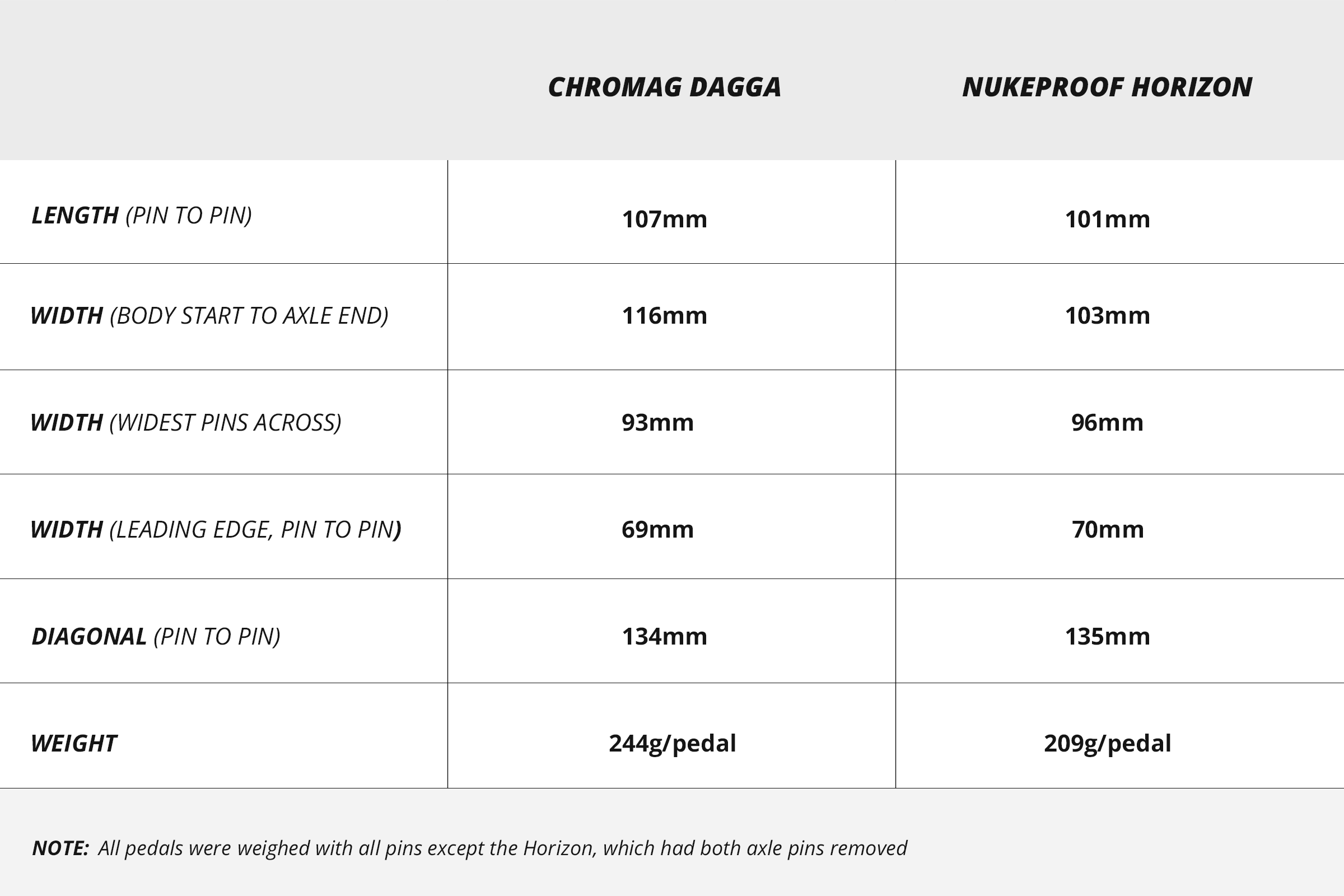
How the Chromag Dagga measures next to the Nukeproof Horizon.
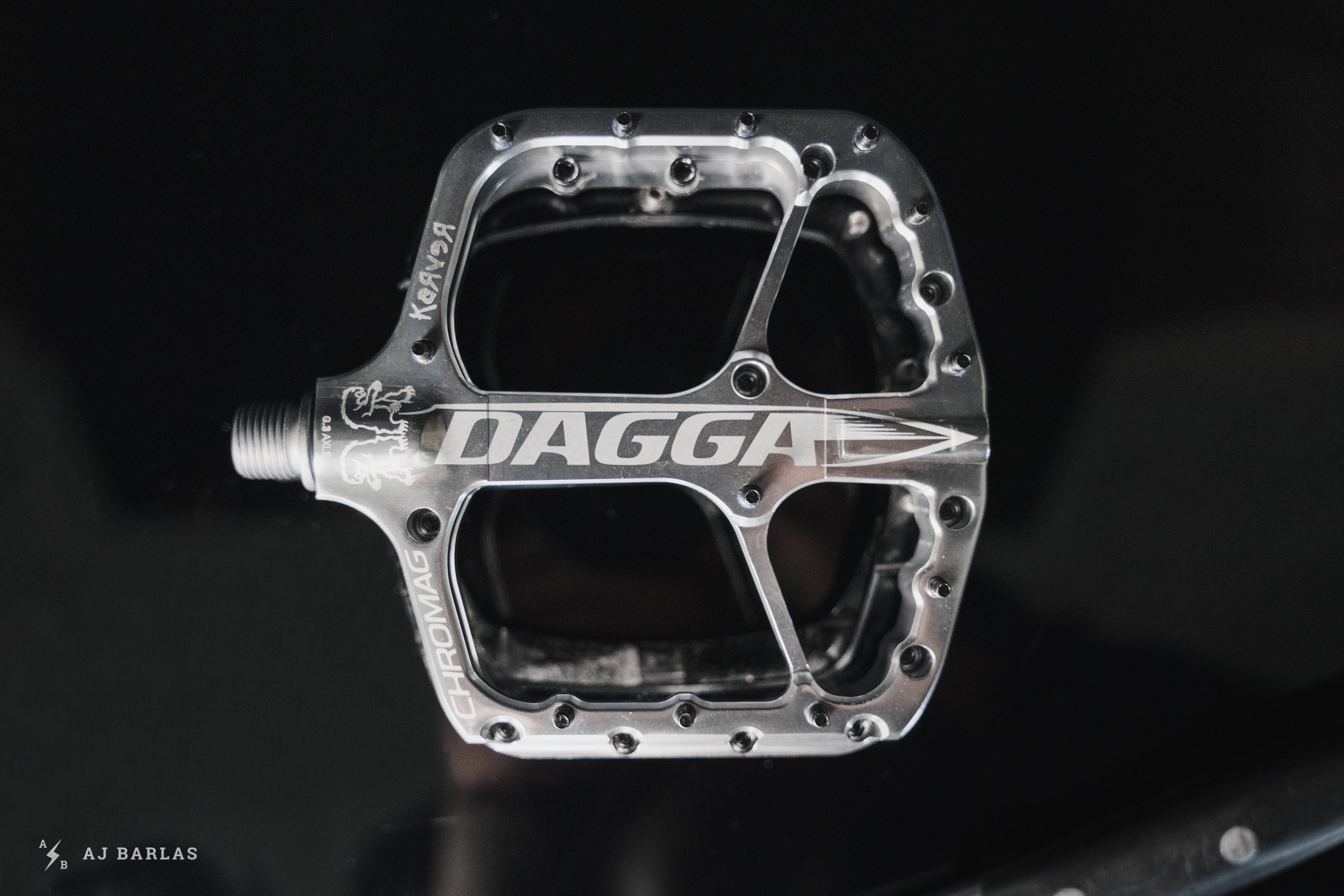
With the axles aligned, the ANVL Tilt V3 appears considerably smaller under the Dagga…
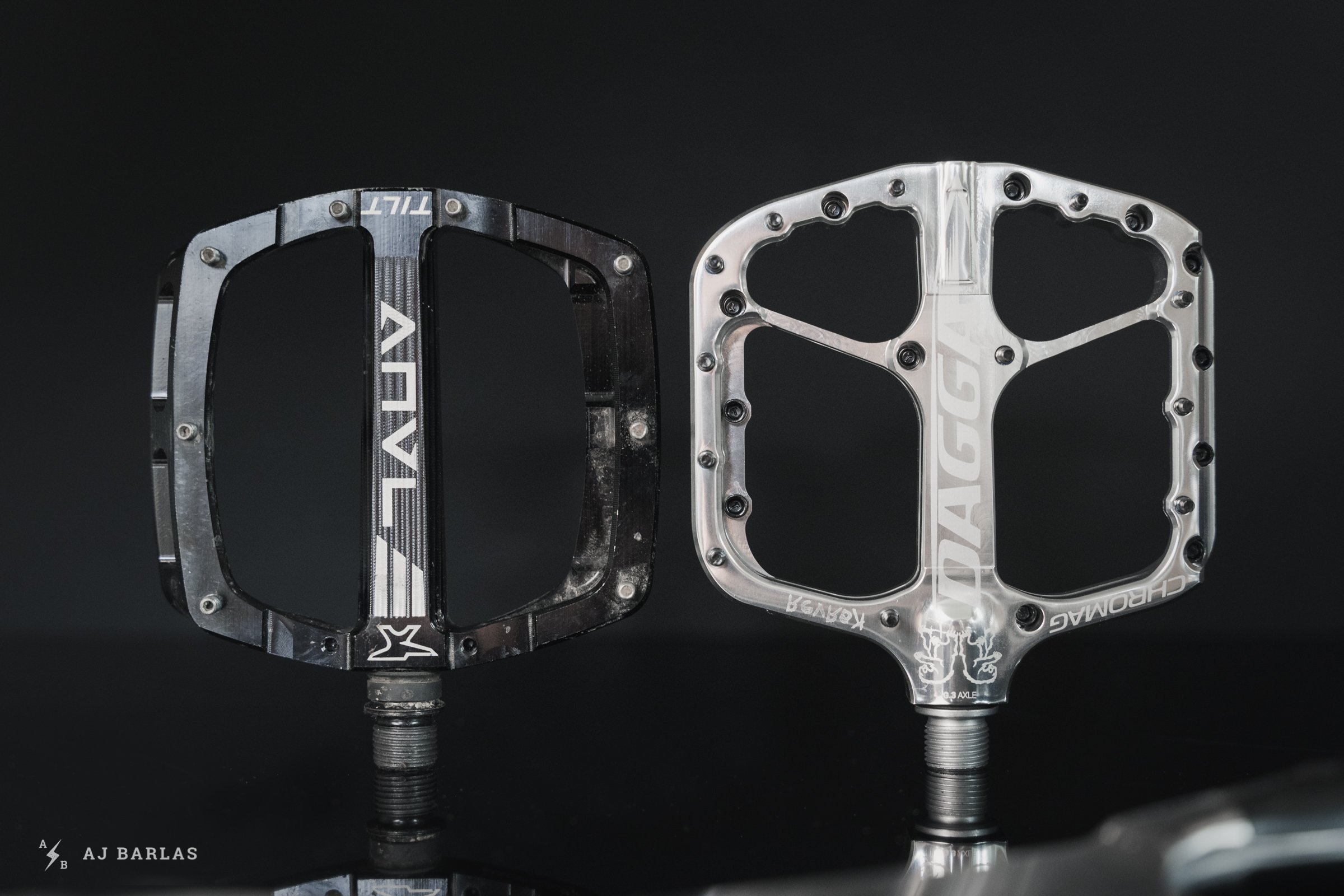
But once side-by-side, the smaller q-factor of the Tilt is visible and when looking at the measurements, the platform for these pedals are almost identical. The wider q-factor of the Dagga provides a more stable stance on the trail.
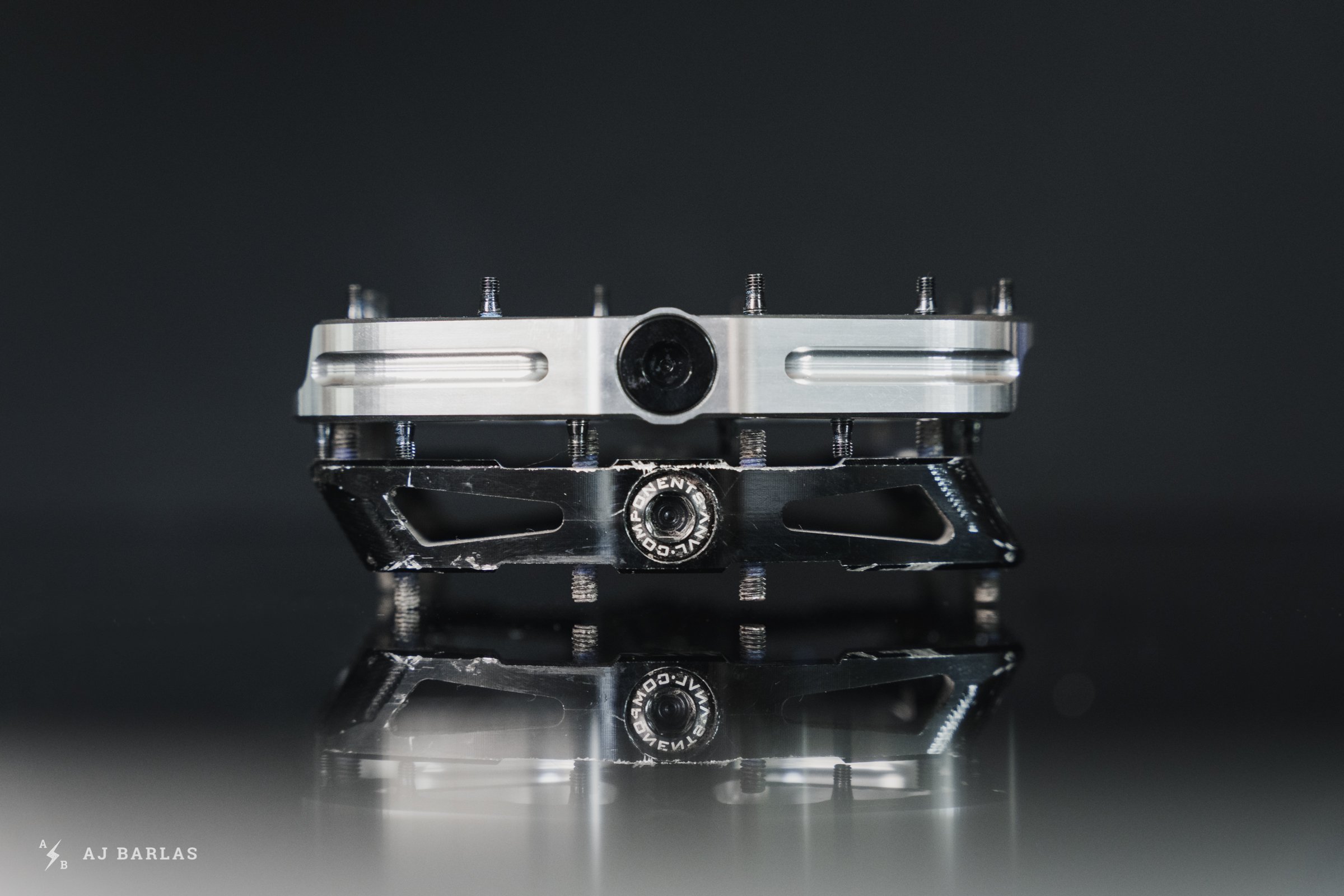
Stacked here the Tilt appears quite a bit shorter in length but a rounder overall shape makes it appear smaller.
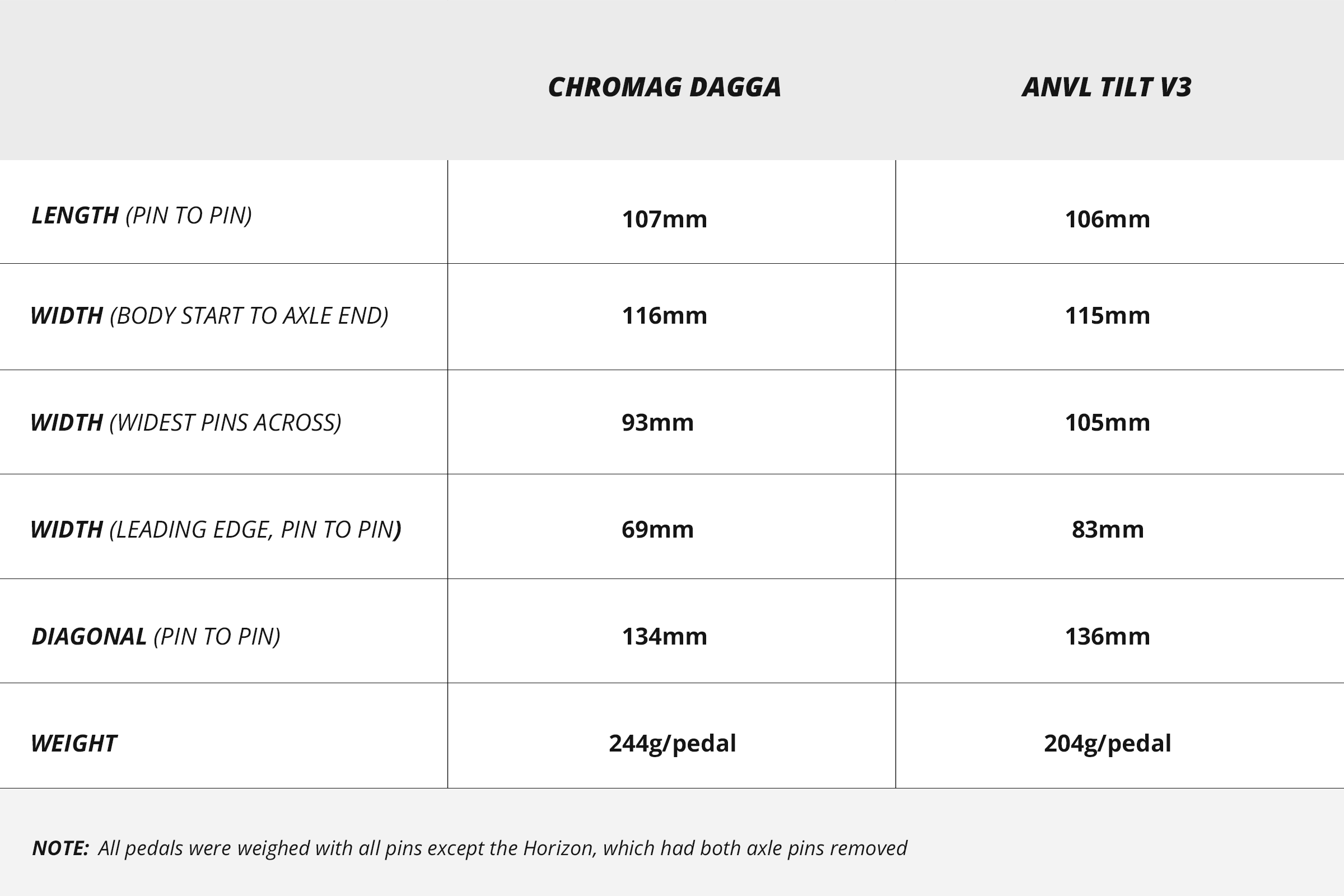
How the Chromag Dagga measures next to the current ANVL Tilt pedal.
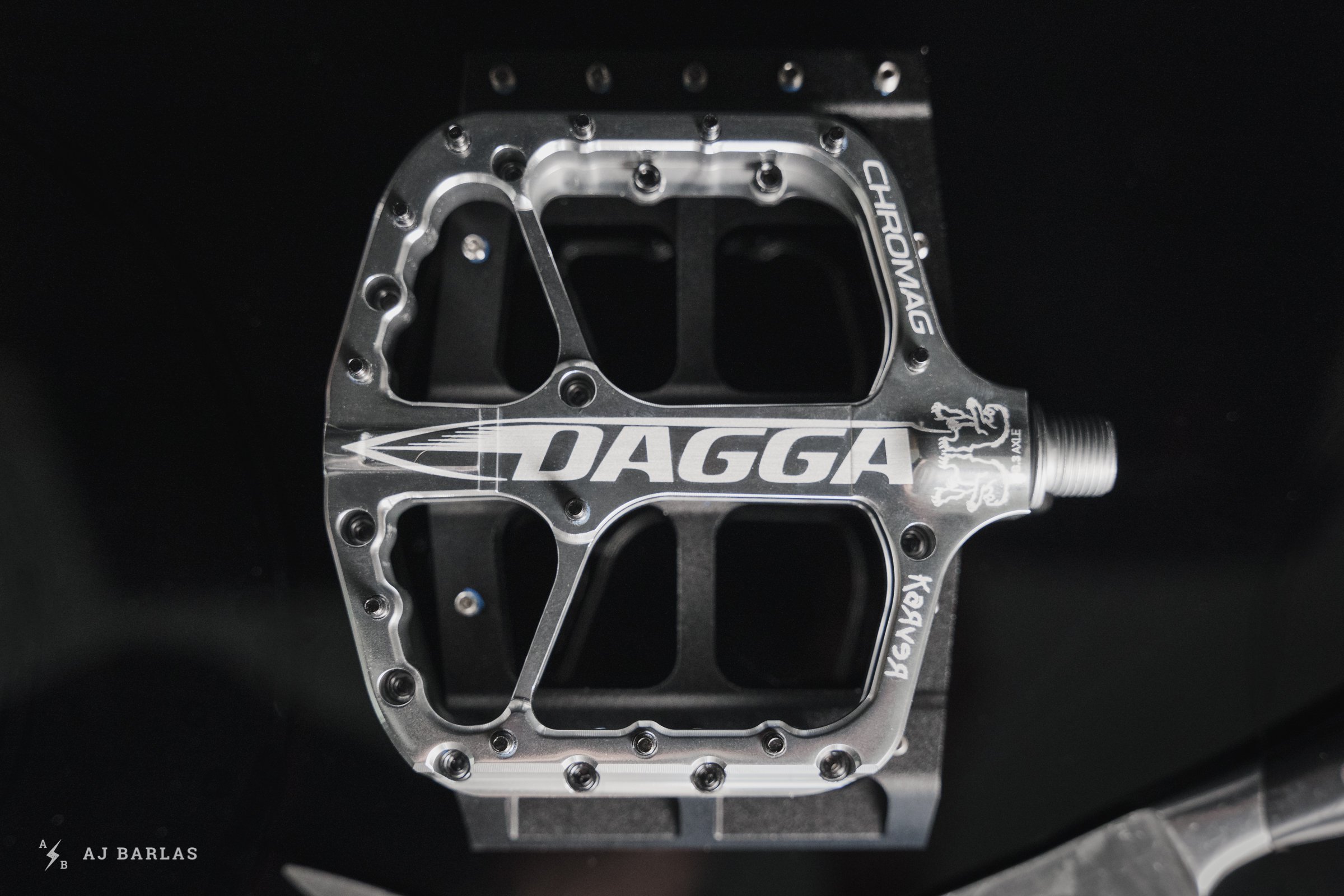
Pedalling Innovations' Catalyst pedal was mentioned as having a hint of design influence after Chromag Employee, Seb Bunney sang their praises. Chromag didn't go to the extreme of the Catalyst though, but did make their pedal wider, both in q-factor and surface width.
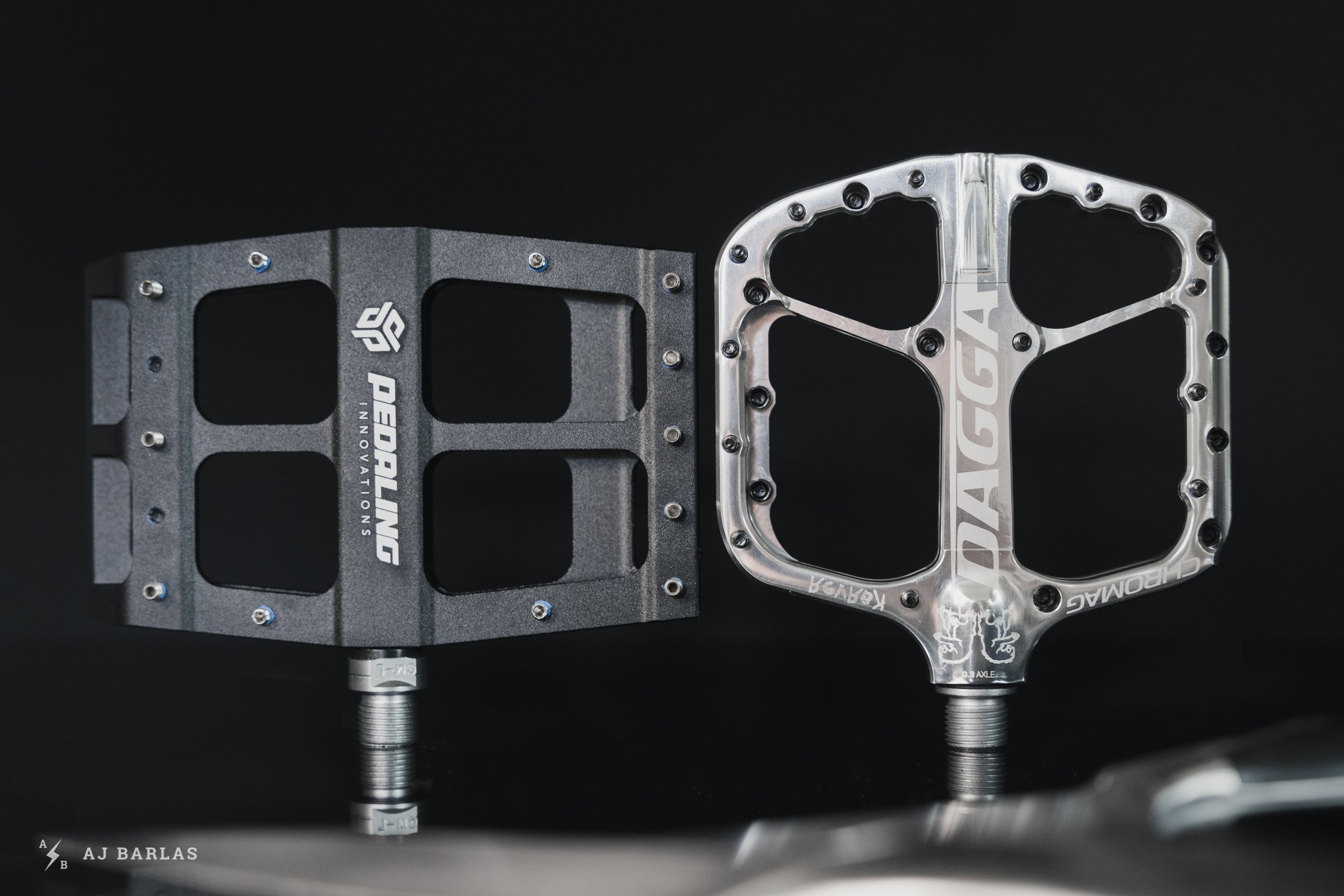
Next to each-other, the difference in width is clear as day. Although the Dagga has a bigger overall wide point, the leading edge on both is within millimetres.
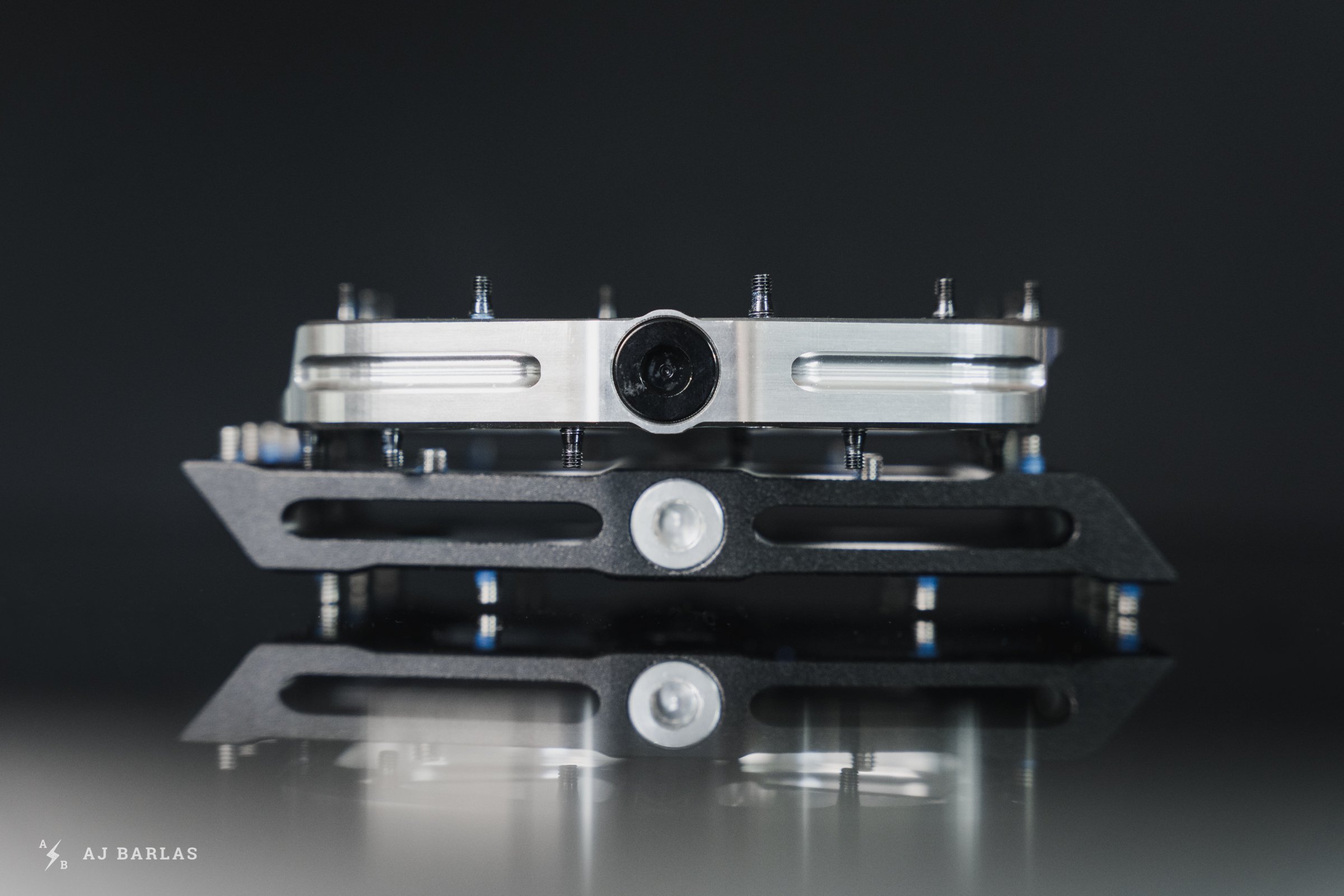
But where length is concerned, the Catalyst dwarfs the Dagga.
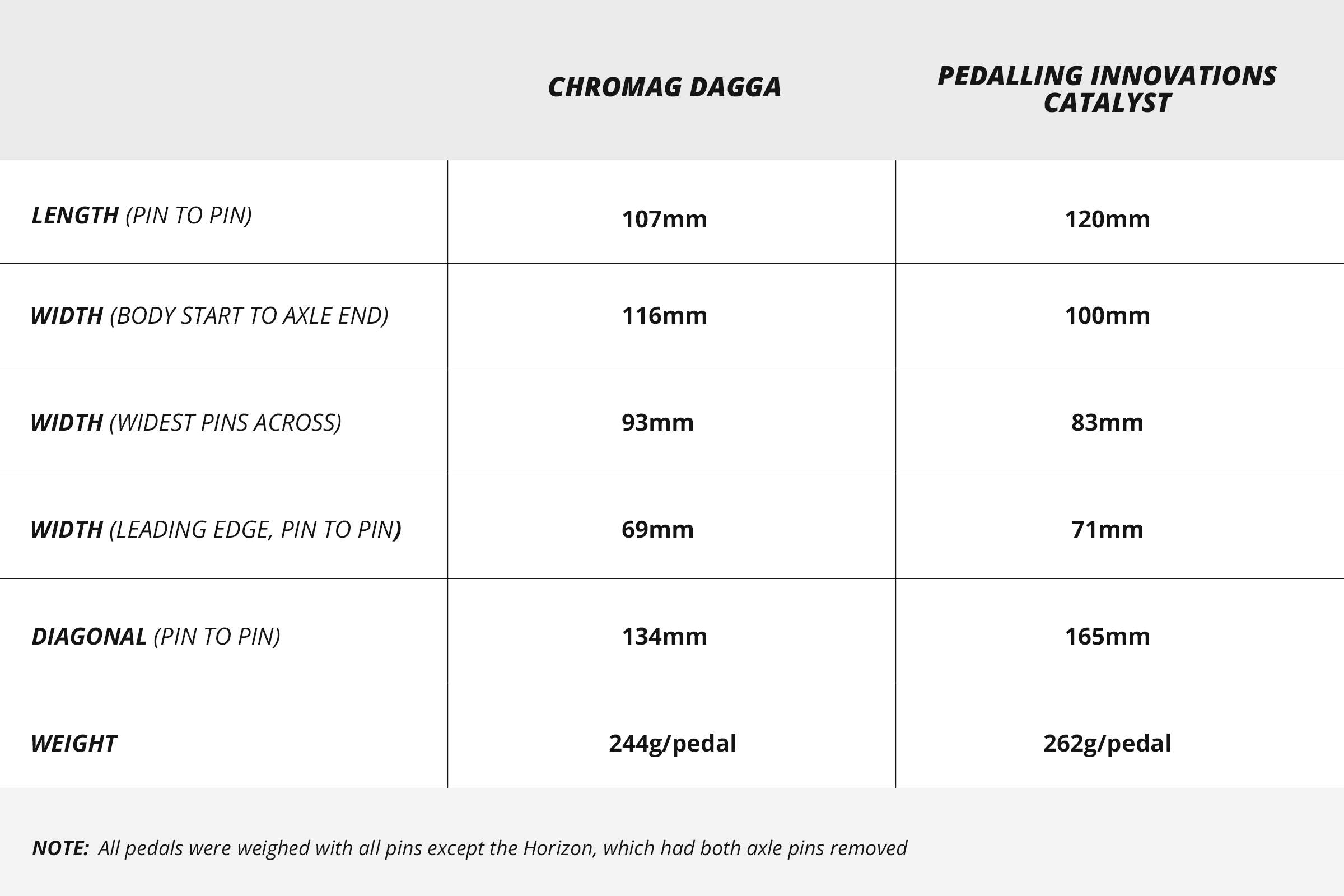
How the Chromag Dagga measures next to the Pedalling Innovations Catalyst.
Verdict
The Daggas feel great underfoot, providing a big platform without increasing pedal strikes. The clean, rounded shape keeps the corners of the pedal under the shoe and out of harm's way. The wider Q-factor is significant for riders who have spent most of their time on previous Chromag pedals or something smaller from another brand. The q-factor bears a close resemblance to pedals like the TMac or Nukeproof Horizon. They feel good, providing more space to balance and when riding mountain bikes in rough terrain, this wide stance is welcome.
While the pins look gnarly, they’re a treat to ride, providing massive grip. Both the stock and long height options provide traction for days but the longer length is best reserved for a shoe with a thick sole – something like FiveTen's range of Impact shoes. For those not picky about concavity, the standard pin height will provide plenty of grip and positive feel. If you prefer a concave shape you might lean toward the longer pin option to fake it. In either case, the Dagga will suit many riders, has heaps of room for customization, and they can take a hiding.
More on the Chromag Dagga pedals on the Chromag website.
Age: 39
Height: 191cm/6’3"
Weight: 73kg/160lbs
Ape Index: 1.037
Inseam: 32”
Trail on Repeat: Changes as often as my mood.
Current Regular: Every test product spends time on Entrail
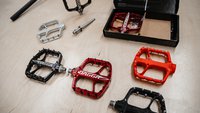
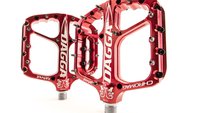

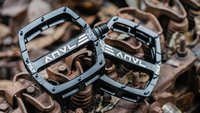







Comments
Agleck7
3 years, 10 months ago
Just got a pair after riding Vaults for years. I actually swapped my Vault pins over to them because I wanted more Q factor not more grip than Vaults. No doubt the dagga pins have more grip but I’m afraid they’re much more likely to lead to stitches if I have a crash and catch a pedal.
So far so good. Similar or better grip than the Vaults (with Vault pins) and better stance for me as a tall guy. Have to admit it wasn’t as dramatic of a feel difference as I expected though.
Would love to see more pedal spindle length options. For example Anvls with 10-20mm more Q factor would be awesome. Don’t feel like i need more pedal body, just always feel like my feet want to be on the outside halfs of pedals and hang off the outside
Reply
chachmonkey
3 years, 10 months ago
+1 on more pedal spindle length options. With technique learned during the years of Vans and 90s BMX pedals, I find that I get plenty of grip with most modern pedals; I just always want a wider Q factor.
Reply
AJ Barlas
3 years, 10 months ago
+2 on axle length options. It would be amazing to truly be able to test a variety of options with the same size platform and find the ultimate setting.
Great to hear you’re getting on with them with the Vault pins, Agleck. The stock pins grip so well though that slipping a pedal seems rare. Hiking the bike up a section requires some physical distancing though, haha.
Reply
Agleck7
3 years, 10 months ago
Makes sense. I'm less worried about slipping pedals, and more about getting sliced if I crash otherwise. happened too many times and stiches/urgent care visits have a cost at home with my wife ;)
Reply
Greg Anderson
3 years, 10 months ago
These look great, but those pins.. they look like terrifying flesh rippers. Cool.
Q factor seems to be an under reported spec in pedal reviews. I tried a pair of Spank Spoon pedals based on another websites very positive review and the q factor was so f'ing narrow they were unusable to me. When I held them up to other pedals I was like "well no shit they didn't work" as they ride incredibly inboard, at least in the size recommended for my shoe size.
Ive used a bunch of different higher-end pedals and the only ones that have gotten the "would buy again" nod from me are the Crank Bros Stamp 7, which I didn't expect would be so good.
I'd give these Dagga's a try for sure if I wasn't in my pedal happy-place right now.
Reply
Cooper Quinn
3 years, 10 months ago
My shins are quivering in fear at those pins.
Reply
Greg Anderson
3 years, 10 months ago
And we all know, no matter how grippy you will eventually slip a pedal even if it takes a snapped chain..
Reply
AJ Barlas
3 years, 10 months ago
Grip vs pretty shins? I know which I’d take but chicken legs are never an attractive attribute anyway… 😆
Reply
Greg Anderson
3 years, 10 months ago
Grip everytime.. Mine no longer even have hair on the front
Pretty Shins?
All Healed
Reply
Rob Gretchen
3 years, 10 months ago
These are my new go to pedals... massive grip and support... love em...
Reply
Brigham_Rupp
3 years, 10 months ago
After trying many pedals over the years, I’ve been on the same Scarabs for at least five years now with zero rebuilds and zero issues. Any thoughts on whether Daggers are worth it for the design changes? I wear US 12 Freerider Pro.
Reply
AJ Barlas
3 years, 10 months ago
With a size 12 shoe, I reckon you’d find great benefit to the Dagga with its wider stance and more support over the length of your foot. If you don’t like the sharper pins you could try swapping in the Scarab ones but still benefit.
Reply
Please log in to leave a comment.